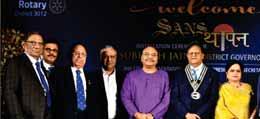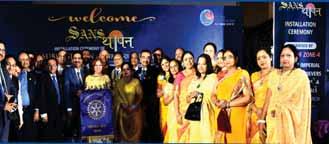





















With Best compliments from PDG John Daniel
Secretary, South Asia Reception, Rotary Convention, Toronto


























With Best compliments from PDG John Daniel
Secretary, South Asia Reception, Rotary Convention, Toronto



12 A single gift of `100 crore for TRF!
Read about D Ravishankar, President, RC Bangalore Orchards, who made waves in the Rotary world with his contribution of `100 crore to the Foundation.
20 It’s Rotary everywhere in Toronto
More than 25,000 Rotarians converged in Toronto to attend the annual Rotary Convention.
24 TRF scales a new high at $372.6 million
TRF Trustee Chair Paul Netzel wows the audience with details of a new high at the Toronto Convention.
36 Trinidad, the land of humming birds
Explore the slangs and sights of Trinidad, off the Venezuela coast, in the Caribbean.
56 Water wheels make fetching water easy
Thanks to the Rotarians of RC Bombay Hanging Garden, taking water cans home is a lot easier.
64 The colourful lac craft might dwindle and die
Innovative technique and traditional skills merge in the lac craft of Jaipur.
70 How to kick out a bad habit
Practising a harmful habit is like being in a hole; prevent it becoming a comfort zone.
72 A meeting of minds
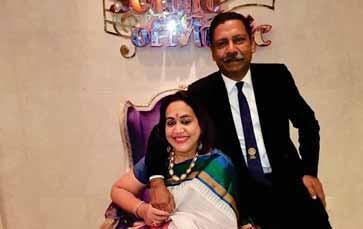













Books give you a peep into a world of ideas and insights divergent from your own. 56
On the cover: An entertainment programme on the inaugural day of the Rotary Convention in Toronto. Picture by Mike Thorn.






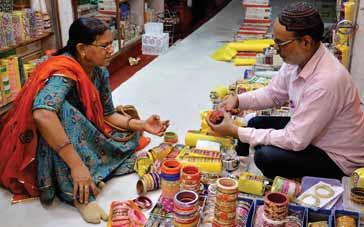
The July issue is superb in its new layout, the cover page and its notable content. The Editor’s note on Ushering in more gender equity, within and outside Rotary aptly describes the necessity of adding more women members in Rotary.
The theme for this year is Be the Inspiration and we are indebted to RI President Barry Rassin for striking a perfect balance between Bahamian bonhomie and decisive leadership and choosing such an effective theme.
The success stories about him are impressive and adaptable; he is a visionary administrator and under his able leadership, Rotary is bound to scale new heights.
The article Where women are given wings by Rasheeda Bhagat has Judge Swati Chavan, a Rotary peace scholar, throwing light on “an innovative project to empower divorced women”. Definitely, this project can be followed by other clubs also. Another story Giving a second chance
More women leaders needed
Your effort to promote gender equity is praiseworthy. In the coming years we will experience a situation in Rotary where more women district governors will steal the show in the leadership contest. Your



to girl dropouts is an effective and useful project being done by RC Ankleshwar.
All other articles are worth reading. My regards to the Editorial team in its efforts to maintain the standard of Rotary News with worthy articles, club reports and clear pictures.
M T Philip, RC Trivandrum Suburban — D 3211
Congratulationson the very appealing new design of the cover page. It’s a great way to welcome the 114th year of our Rotary journey. The new look has made Rotary News appear bolder, better and more distinct.
statement that ‘women are cost conscious’ is widely acknowledged. It is really an encouraging sign that women are coming out and becoming visible in every field. The existing chaos and anarchy prevailing in society will end and a new world order will be established once gender equity
I am sure the reach is going to be phenomenal. It’s bound to enhance the public image of our organisation. Let’s keep reinventing ourselves for the better. Kudos to you and the entire team.
DG A V Pathy — D 3201
Though I am impressed with the entire content of the July issue, a special mention has to be made about the Editor’s Note and the interview of Rotary Peace Scholar Judge Swati Chavan ( Where women are given wings ) of Pune on women’s empowerment.
Our society is blessed with the presence of devoted and selfless women, who struggle to lead a stable and peaceful life. They prove themselves as the best achievers both at work as well as at home. They are gifted and balance all situations. In Rotary, we can see good examples of women who have taken up district and club leadership in recent years. Thanks to the Editor for featuring regularly interesting
becomes a reality. It is not a Utopian view but based on truth and realism. Arun Kumar Dash RCBaripada—D3262
Proud to be Rotarian
In the article Rotary honours a philanthropist par excellence (June issue), I was surprised to
note a statement of PRIP Kalyan Banerjee, which says “An Italian Rotarian instantly gave a cheque for $1million for relief work in Kutch after it was devastated by a massive earthquake. He never asked me how his money was spent nor did he visit India. It can happen only
articles on women and their special skills not only in Rotary, but elsewhere too.
R Srinivasan
RC Madurai Midtown — D 3000
The interview with Judge Swati Chavan was impressive, instructive and inspiring. The Judge vividly explains the problems of deserted and divorced women in society. The main problem is getting the alimony order implemented. She has pointed out that men are ready even to go to jail but they do not want to pay the maintenance amount to divorced wives. In this context, the innovative project of Swayam Siddha to train divorced women in some gainful employment will certainly help them lead an independent and peaceful life. Rotary clubs from across India should come forward to participate in this pragmatic project for divorced women as suggested at the meeting by PRIP Kalyan Banerjee.
S Lakshmanan
RC Ambasamudram — D 3212
in Rotary.” It is really an honour being a Rotarian.
NJagatheesan,RCEluru—D3020
World-class content
Iam a Rotarian since 2010 and a regular reader of Rotary News. I compliment you and your Editorial team for bringing out a magazine
with world-class content, articles and listing of Rotary projects done across districts. Once I receive the magazine on the 10th of every month, it is unputdownable as most of the articles are engaging and interesting. Kudos to you and your team.
NipunPatel,RCKankaria Ahmedabad — D 3054
A project will get replicated
Club of Mandi is thankful to you for publishing the story of our leaf plate project (Improving women’s livelihood). The story was well done by Kiran Zehra who added the recent ban on plastic and thermocol plates in Himachal Pradesh and interviewed the members of RCC Gharwasra. She has also well explained in the article that these eco-friendly leaf plates have health benefit. I have now been requested by many clubs in our district to give details of this project so that they can also start such a project in their community.
Surender Mohan RC Mandi — D 3070
Themessage from the RI President and RI Director is really inspiring. No doubt all Rotarians are obliged to and should inspire the new members as well as the existing ones

to contribute to Rotary in all avenues of service. The club president should lead from the front.
Peter Drucker, the Father of Modern Management, once said: “The secret of success is 1 per cent inspiration and 99 per cent perspiration.” So, the entire army of Rotarians should not wait for someone to inspire to get into active work, rather they should proactively start to work right now and continue forever.
Dr NRUK Kartha RC Trivandrum Suburban — D 3211
Promote Rotary on social media
AsRotarians, we all have hundreds of amazing stories about the work that our clubs accomplish in our communities. It’s time every club effectively uses social media to spread the good word beyond the network of Rotary clubs.
Social media has revolutionised the way people connect with friends, family and acquaintances. Hence, clubs must post their projects and programmes on non-Rotary sites and networking groups with good pictures accompanying the details. A club can thus effectively create a positive public image of Rotary in society.
R Murali Krishna
RCBerhampur—D3262
Rtn D Ravishankar of Hara Builders, the President of Rotary Club of Bangalore Orchards, D 3190, has donated `100 crore to The Rotary Foundation. Hats off to his grand donation for a noble cause which will help TRF to work for a much better world. Hasmukh Patel, RC Pune Westend — D 3131
We welcome your feedback. Write to the Editor: rotarynews@rosaonline.org; rushbhagat@gmail.com
RI Dist 2981 DG S Piraiyon
RI Dist 2982 DG Nirmal Prakash A
RI Dist 3000 DG RVN Kannan
RI Dist 3011 DG Vinay Bhatia
RI Dist 3012 DG Subhash Jain
RI Dist 3020 DG Guddati Viswanadh
RI Dist 3030 DG Rajiv Sharma
RI Dist 3040 DG Gustad Anklesaria
RI Dist 3053 DG Priyesh Bhandari
RI Dist 3054 DG Neeraj Sogani
RI Dist 3060 DG Pinky Patel
RI Dist 3070 DG Barjesh Singhal
RI Dist 3080 DG Praveen Chander Goyal
RI Dist 3090 DG Dr Vishwa Bandhu Dixit
RI Dist 3100 DG Deepak Jain
RI Dist 3110 DG Arun Kumar Jain
RI Dist 3120 DG Stuti Agrawal
RI Dist 3131 DG Dr Shailesh Palekar
RI Dist 3132 DG Vishnu S Mondhe
RI Dist 3141 DG Shashi Sharma
RI Dist 3142 DG Dr Ashes Ganguly
RI Dist 3150 DG Ramesh Vangala
RI Dist 3160 DG Konidala Muni Girish
RI Dist 3170 DG Ravikiran Janradan Kulkarni
RI Dist 3181 DG Rohinath P
RI Dist 3182 DG Abhinandan A Shetty
RI Dist 3190 DG Suresh Hari S
RI Dist 3201 DG A Venkatachalapathy
RI Dist 3202 DG Dr E K Ummer
RI Dist 3211 DG E K Luke
RI Dist 3212 DG K Raja Gopalan
RI Dist 3231 DG C R Chandra Bob
RI Dist 3232 DG Babu Peram
RI Dist 3240 DG Dr Sayantan Gupta
RI Dist 3250 DG Kumar Prasad Sinha
RI Dist 3261 DG Nikhilesh M Trivedi
RI Dist 3262 DG Bhabani Prasad Chowdhury
RI Dist 3291 DG Mukul Sinha
Printed by P T Prabhakar at Rasi Graphics Pvt Ltd, 40, Peters Road, Royapettah, Chennai - 600 014, India, and published by P T Prabhakar on behalf of Rotary News Trust from Dugar Towers, 3rd Flr, 34, Marshalls Road, Egmore, Chennai 600 008. Editor: Rasheeda Bhagat.
Board of Permanent Trustees & Executive Committee
PRIP Rajendra K Saboo RI Dist 3080
PRIP Kalyan Banerjee RI Dist 3060
PRID Sudarshan Agarwal RI Dist 3011
PRID Panduranga Setty RI Dist 3190
PRID Sushil Gupta RI Dist 3011
PRID Ashok Mahajan RI Dist 3141
PRID Yash Pal Das RI Dist 3080
PRID Shekhar Mehta RI Dist 3291
PRID P T Prabhakhar RI Dist 3232
PRID Dr Manoj D Desai RI Dist 3060
RID C Basker RI Dist 3000
TRF Trustee Gulam A Vahanvaty RI Dist 3141
RIDE Dr Bharat Pandya RI Dist 3141
RIDE Kamal Sanghvi RI Dist 3250
Executive Committee Members (2018–19)
DG Rajiv Sharma RI Dist 3030
Chair – Governors Council
DG Pinky Patel RI Dist 3060
Secretary – Governors Council
DG Subhash Jain RI Dist 3012
Secretary – Executive Committee
DG A Venkatachalapathy RI Dist 3201
Treasurer – Executive Committee
DG Shashi Sharma RI Dist 3141
Member – Advisory Committee
ROTARY NEWS / ROTARY SAMACHAR Editor Rasheeda Bhagat Senior Assistant Editor Jaishree Padmanabhan
ROTARY NEWS TRUST
3rd Floor, Dugar Towers, 34 Marshalls Road, Egmore Chennai 600 008, India. Phone : 044 42145666
e-mail: rotarynews@rosaonline.org Website : www.rotarynewsonline.org
The views expressed by contributors are not necessarily those of the Editor orTrustees of Rotary NewsTrust (RNT) or Rotary International (RI). No liability can be accepted for any loss arising from editorial or advertisement content. Contributions – original content – are welcome but the Editor reserves the right to edit for clarity or length. Content can be reproduced, but with permission from RNT

It’s been a season of heartbreaks, but also generosity and triumph of the human spirit. Let’s take the heartbreaks first from the FIFA World Cup or Russia 2018 to the iconic Wimbledon, where the king of tennis, Roger Federer was sensationally knocked out of the tournament, surrendering a two-sets lead and a match point to lose to the lanky South African Kevin Anderson. Till today Federer has never lost at Wimbledon having held a match point, but then the power of belief at the opponent’s end triumphed. Anderson said later, “I kept fighting and telling myself to keep believing. I said today is going to be my day.”
Whether Federer lost because he was playing “safe, stiff tennis, or his form had gone or his confidence or back,” as someone commented on Twitter, we will never know. Because while triumph is celebrated in public, failure is always reflected upon in private.
In Russia, so many stories unfolded… of triumph and heartbreaks. Football legends like Cristiano Ronaldo and Lionel Messi let down their teams badly when their skill and expertise were needed the most. Both missed crucial penalty shots and the formidable Messi scored only one goal in the whole tournament. And the mighty Argentina as well as Brazil, Portugal and even Spain were knocked out at early stages. Messi is said to be considering retirement after his dismal performance. But then greatness is made of a different mettle. Take Federer for instance. On May 3, 2016, a column titled “Why Roger Federer will never win another grand slam” in the UK daily The Telegraph made convincing arguments — age, knee and back injuries, more physical endurance levels from younger tennis players, etc — and
concluded: “The most likely outcome before Federer retires is that he will end his career with 17 slams.” And yet, come January 2018, and we had a beaming Federer collecting his 20th Grand Slam title at the Australian Open, where another Tennis legend Rod Laver shot a picture of him crying!
It is the absence of arrogance that makes Federer so endearing, and which abounds in Rotary too. Recently I interacted with a Rotarian who describes himself “a nobody and of less than average intelligence”. And that is D Ravishankar, President of the Rotary Club of Bangalore Orchards, who stunned the Rotary world by announcing a donation of `100 crore (about $14.7 million) for TRF. While DG Suresh Hari’s batchmates joke with him that forget his own District goal, this generosity has covered more than half of India’s TRF goal for this year, Ravishankar remains unfazed. Dismissing words such as philanthropy as “big words” and insisting that what he did is a “simply giving away my money to society which I consider my father who I had lost when I was in Class 4”, he describes the harsh conditions under which he grew up. And the myriad ways in which different people helped him — ranging from giving food to a starving kid to government clearances without bribes. Read his story in this issue and prepare yourself to be blown away by the humility of this man... who can, with just a snap of his finger, give away `100 crore to fulfil his dreams… to build schools, provide hygiene and health care for deprived children, not only in India but also an odd school in rural Pakistan “because we were all one people before the Partition divided us”.
Rasheeda Bhagat

Dear fellow Rotarians,
well-known saying goes,
“If you want to change the world, go home and love your family.” That doesn’t mean people should ignore the needs outside their own homes; instead, they should pay attention to the needs within.
It can be tempting, when our priority is service, to focus only on the things that look like service: the projects, the planning, the work that yields a visible benefit to those who need it. But to do that work effectively, we need to keep our own house in order. In Rotary, that means conducting ourselves in accordance with the principles of Rotary, treating others with respect, and following The Four-Way Test. It means maximising our impact by planning carefully and stewarding our resources wisely. And it means looking after the long-term health of our organisation by ensuring that our membership is strong, engaged and healthy.
Our membership has hovered around the same 1.2 million mark for 20 years. We aren’t growing, and our membership is getting older. We have too many clubs that
don’t have the knowledge or motivation to have an impact: clubs that don’t know what we’re doing on a global level, clubs that don’t know about our programmes or our Foundation, that don’t even know how to get involved. And with a membership that is still mostly male, we clearly aren’t doing enough to become the organisation of choice for women who are seeking to serve. We are a membership organisation first. If we want to achieve the goals we’ve set for ourselves, we need to put membership first. All of us have a responsibility to take membership seriously, not only by inviting prospective members, but also by making sure new members are welcomed into clubs that offer them something of value. If you see someone walk into a meeting and hesitate, be sure that person has a place to sit and is part of the conversation. If you’re enthusiastic about a Rotary programme, make sure your club knows about it and knows how to get involved. If you see a need in your community, talk about it at this week’s meeting. If we want to be part of an organisation that’s strong, that’s active, that’s having an impact — start at home, and Be the Inspiration in Rotary.
Barry Rassin President, Rotary International

Dear Rotarians,
One vivid memory of my college days is the ‘30 days book’, which was very popular then; it worked on a simple principle — one can learn any language within 30 days. One month of our ongoing Rotary Year has gone and we have just 11 months left. I am reminded of Robert Frost’s line: “I have miles to go before I sleep”. Much needs to be done and time does not stand still. Many clubs would have inducted new members during the Club President installation programmes. Our impact starts with our members — the people who work sincerely with their clubs to solve some of our communities’ immediate challenges.
Diversity is a source of innovation, as well as one of Rotary’s core values. Having members from different backgrounds, ethnicities and cultures give our clubs a broader understanding of the community, its challenges and possible solutions. Apart from growth, we need to work on retention. Rotary International has conducted extensive research globally on the reasons members leave their clubs. The result: Members who leave within the first year do so because they were not fully informed about the responsibilities of membership before joining or were not fully educated about Rotary after joining.
I have seen for myself in renowned clubs, retention rates are higher, as members feel valued because they feel their contribution makes a difference. These clubs do regular classification assessments looking for new classifications that come out of economic and industrial developments in their respective cities. Probably in the early sixties there
was no Computer and IT services related classifications. That was the time IBM and ICL entered the country and that was the beginning of the classification called “Data Processing”. Today new classifications are opening up every week with the expansion of industry, trade and technology in different sectors.
Success of retention is not merely retaining members and engaging them. Membership retention is keeping those members involved and excited about the club every day. Plan programmes at least once in two months where the club members interact with one another in an informal ambience and build positive dynamics. This exercise will lead to forming a successful team of Rotarians that knows each other’s strengths and weaknesses well and can support one another.
Let us request fellow Rotarians to identify people they know in their local communities who would be assets to the club — an important step in membership growth. Encourage others to invite prospective members to club meetings, service projects and community events so that they can see how your club helps the community and provides opportunities to form connections and friendships.
Rotary has been making history and bringing our world closer together for over 113 years. It is Rotary’s ethos to serve humanity and bring peace to the world, say goodbye to conflicts and strengthen Rotary by “keeping the Member in Rotary and keeping Rotary in the Member”.
Be the Inspiration, ask Rotarians to inspire each other and together we’ll change the world.

C Basker Director, Rotary International

ithout The Rotary Foundation’s Endowment Fund, our efforts would be for naught. The endowment is the backbone of Rotary’s efforts around the world, providing access to the time, talent, and resources needed to make a difference. Our goal of building the Endowment Fund to $2.025 billion by 2025 and this year’s fundraising goal of $380 million are surely some of the most important tasks at hand for our organisation.
Your financial support has made possible every single thing that Rotary has done over the years. But what’s equally essential — and might sometimes be in danger of being overlooked — is your participation.
Without you, Rotary is nothing. The Foundation needs your presence, your input, and your creative mind just as much as it needs your generous financial backing. Your Rotary club needs you to be there at meetings — not to warm a chair, but to engage, to inspire.
I shared last month how my relationship with Rotary changed when I went from being a tepid (at best) seatwarmer to a committee chair who was engaged and focused. You don’t need to wait for someone to ask you to chair a committee or be a club officer to begin to transform your Rotary journey. There’s a place in Rotary for all of you to step up and become people of action.
Be engaged. Working with your club on service projects that qualify for District Designated Funds is one way to participate and use your voice to make a real difference. If your club has no service projects that interest you, work on getting some new ones underway. Carry out community assessments to find out how we can best use our resources to create positive change.
This month, I invite you to transform the way you think about your involvement with Rotary. Consider every meeting a chance to discover new channels for your energy and to brainstorm with like-minded Rotarians about how you can work together for a better world. Message from the Foundation Chair
Gundula Miethke

In the past 15 years, cafés and fashionable shops have opened all over Hamburg. When you attend the 2019 Rotary International Convention there from June 1 to 5, take a little time to experience what the city has to offer.
On a sunny day, start with breakfast by the shores of the Outer Alster Lake (Außenalster) on the deck of Alster Cliff, a café with stunning views. Try the “Seaside,” scrambled eggs on dark rye bread topped with tiny shrimp.
From here you can stroll into the Pöseldorf neighbourhood, which boasts cozy restaurants, art galleries, antique shops and high-end boutiques. Or take the steamboat that departs every hour from the Fährdamm dock to the Jungfernstieg, a historic lakeside boulevard in the heart of the city.
On the Jungfernstieg and adjoining streets, you can snack and people-watch in one of the numerous cafés. You’ll find international stores such as Apple, Hermès and Gucci, along with family-run businesses such as Chocolaterie Leysieffer. Make sure you visit Steiff, the teddy bear maker, inside the traditional brick mall called Levantehaus, and check out the stylish Europa Passage designed by star architect Hadi Teherani.
For alternative fashion and design, head to the Karolinenviertel, a vibrant artists neighbourhood with studios and shops run by young local designers. Enjoy a German-style cheesecake at Gretchens Villa.
Ron D Burton Foundation Trustee Chair
Rotary International South Asia Office, Pullman / Novotel Commercial Tower, First Floor, Asset No.2, Hospitality District, Aerocity (Near IGI Airport), New Delhi 110037
All club and district officials are requested to maintain their email IDs updated through MyRotary to ensure all important communications are received by them.
Club and district officers can access applications, forms and documents to carry out club and district tasks, such as updating club/officer/member data; running reports; paying dues; viewing contribution information; chartering a club, through https://my.rotary.org/en/manage/ club-district-administration/ club-administration.
Rotary Foundation (India) has partnered with 26 corporates and has received CSR fund of $1.36 million since it opened its doors in October 2016 to receive CSR funds for implementing its programmes in India. In RY 2017–18, RF(I) has received CSR fund of $0.93 million from 19 corporates; with following three being repeat donors:
Gestamp Automotive India Pvt Ltd (D 3131) Airef Engineers Pvt Ltd (D 3012)
Naini Group (D 3110)
Training resources
Do you need help planning a training meeting? The “For Trainers” section in the RI website (https://my.rotary.org/ en/learning-reference/learnrole/trainers) provides detailed
information on planning a meeting, training Rotarians, web conferencing and the role of the club trainer. These pages contain many related resources such as checklists and worksheets that can help prepare for ‘online’ training meetings.
Membership Minute and other newsletters
The Membership Minute newsletter comes through email, provides information on resources, tools and membership development ideas. It also features latest research on Rotary membership, suggestions about where to find and how to recruit qualified, committed Rotary club members, ideas for creating or enhancing new member orientation programmes and tips and trends for keeping and retaining members.
You may like to subscribe the above mentioned “online” resource and other newsletters at https://my.rotary.org/en/ news-features/newsletters.
Community assessments lead to success Clubs and districts that apply for a global grant to support a humanitarian project or a vocational training team will have to mandatorily conduct a community assessment first and include the results in their grant application.
Staff support for grants
The Rotary Grants staff at the RI headquarters are your best resources for grant applications. Staff can conduct a preliminary application review or help sponsors redesign projects to meet Foundation requirements. To request a preliminary review, contact your grant officer or write to grants@rotary.org.
Effective storytelling through PEOPLE OF ACTION campaign
One of the surest ways to spread word about the fantastic work our clubs engage in, is to collect and share relevant written and visual stories. It is very important to tailor our stories to resonate the People of Action campaign.
How can districts and clubs take part?
Send your People of Action stories to The Rotarian and Rotary News
Spread the word and talk to your club about the importance of promoting public image Familiarise yourself and use existing public image resources on Brand Centre
Access People of Action creatives on Brand Centre and use them in all communication online and offline
Engage your district’s communication experts and create good stories with your clubs and share them with RISAO, RI for further promotion.




Rasheeda Bhagat


When a Rotarian donates a whopping sum of `100 crore or $14.7 million to The Rotary Foundation, the first question you ask him is how and when the idea was planted in his head. D Ravishankar, President, Rotary Club of Bangalore Orchards, D 3190, travels back over five decades to answer it. An important takeaway from his days as a young boy in a government school — a private school was beyond his reach — was the refrain by a senior teacher who’d say: “You should give till it hurts, because till then you are sharing your comfort, not everything that you have.”
While relating this, Ravishankar pauses, and says softly: “I think 90 per cent of the people didn’t like what I did, because I pricked their conscience. Anyway, I believe that beyond a point what you keep turns into poison… poison not for yourself, but your kids and their future.”
With a chuckle he adds that when a friend, who is an income tax commissioner asked him “why I gave away so much money, I asked him how much money a prominent politician took after passing away. If you can tell me, I’d like to store my money in that place.” His philosophy is simple: if you leave more than necessary money for your children, you’ll spoil them. “Whereas on the other side, it is required so badly; people are dying of hunger and are deprived of so many things. I believe
I am only a co-worker; every Rotary club member is a leader. I can’t lead leaders, I can only work with them.
I’d knock on a friend’s door and ask: Amma, I am hungry, give me something to eat. Not one person refused. They’d make rotis or dhal and feed me.
whatever money I have belongs to society. I am just a custodian for a short while; I didn’t bring it with me nor can take it with me.”
On this magnanimous gesture which was announced by Ravishankar at the installation of Suresh Hari as District Governor, the DG says, “Ravi is a wonderful soul and over the last two years specially he has evolved into a different kind of person.”
He adds that discussions with him had started about a year ago, while meeting the Presidents-elect of his district. In further meetings Ravishankar discussed his plans for a microcredit programme, building a Peace Tower at the Wagah border, an old-age home and a Rotary Institute for Peace and Conflict Resolution in this part of the world. “And then he threw a shocker at me by saying he wanted to allocate `100 crore for his chosen projects during 2018–19. I convinced him to give to our Foundation which could initiate work on his pet projects.”
Congratulating Ravishankar for his generosity and setting a great example, RI Director C Basker quoted a verse from the Gita, which says, “A gift is pure when it is given from the heart to the right person at the right time and at the right place, and when we expect nothing in return.”
The reality of our world was that while “in many countries there are masses who don’t even have access to basic day-to-day requirements,
When Bill Gates contributes to TRF, we say it’s fine; but when someone like Ravishankar, literally a nobody, decides to give 70 per cent of his earnings to TRF, we have to say ‘Wow’.
Paola Ravishankar
others have so much in excess, that if their wealth is shared, it would solve many problems related to health, hunger and conflicts in most communities all over the world.”
To understand Ravishankar’s philosophy of giving, stated simply, starkly and without much fuss, let’s travel back to his early childhood. His father Kamesh was a freedom fighter and influenced by Vinoba Bhave’s Bhoodan movement, gifted away all the land he had — some 7–8 acres. “He was in the final year of engineering and burnt all his books which were British and went to prison for about four years. He was given the Tamrapatra to recognise him as a freedom fighter.”
After Independence he got a job as an engineer and Ravishankar and his six siblings led a comfortable life during their early childhood. But when he was in Class 4, his father suddenly passed away, leaving his mother
with seven children and barely `100 in the bank.
“She really had to struggle to bring us up; a very proud woman, she refused to beg. But thanks to the goodwill my father had as the general manager of a company, both my brothers got jobs.”
Society, his father
From thenceforth, adds Ravishankar poignantly, “society took the place of my father, so giving back this money (`100 crore) to my father was not a big thing for me.” On the face of it, this might sound hyperbolic but as you listen to his story, the depth of feeling with which it is stated sinks in. Though he ended up with a BA degree and a diploma in business administration and marketing management, it wasn’t a smooth ride. Never “a good student”, he failed in Class 10 not once but twice. “After losing my father, I fell into bad company, stealing things, black marketing cinema tickets, and so on.” But after failing in his high school exam a second time, “because
I couldn’t see my mother crying, I studied enough to pass with the bare minimum pass marks!”
In 1972, he joined the Bangalore National College for a BA in Economics, with Sociology and Psychology. Here he was inspired by Dr Narasimhaiah, a freedom fighter, and an eminent educationist who went on to become the VC of Bangalore University.
But it wasn’t an easy ride: he recalls growing up on just rice and vegetables such as cucumber. “For proteins I’d buy groundnuts for 50 paise. If I felt hungry, I’d go to a friend’s house, ring the bell, and when his mother or grandmother opened the door, ask straightaway: Amma, I am hungry, can you give me something to eat? Not one person refused. Everybody would call me inside, make rotis or dhal and feed me. Society fed me... people whose hearts were so pure fed me. Were they fools? No, they had pure hearts; they are all dead and gone, but I have to give back.”
When I comment he is philosophic in his thinking,
he quips: “I’d describe myself as below average intelligent. If you are intelligent, you will complicate things. But if you are below average, you’ll think simple. If someone asks me to walk, I’ll walk straight and not do somersaults. You need intelligence to be a liar, thief or a crook. I am a simple man.”
In 1980, he began working in a small company at a salary of `105. “I had to change three buses to reach office, leaving home at 5 am to reach at 8.30 am. I carried for lunch leftover rice or kanji.” And while changing

I have below average intelligence. You need intelligence to be a liar, thief or a crook.
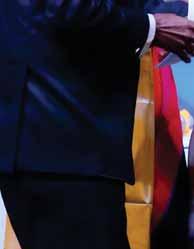
buses he would buy a banana “for nutrition. It cost 5 or 6 paise, but the vendor would give it to me for 2 paise knowing that was all I could afford.”
Another kind act by Society!
He worked in printing and designing and stayed here for a couple of years but “got fed up after some time… and mulled the idea of even joining politics where I could change lives or touch more people, but ended up in real estate.”
Success in Business Ravishankar recalls the excessive red tape that
dominated all sections of business in those days. “But when you grow up on the street you become street-smart. I knew how to talk and get things done… and go around government red tapism. When the supply is less, prices go up and red tapism reduced land supply. But I learnt how to circumvent this; even bad people would be nice to me.”
He got around the massive corruption in getting permits; “I’d simply stand before the people in charge, scratch my head and say if I pay

President of RC Bangalore Orchards D Ravishankar and wife Paola being felicitated at the installation of District 3190 DG Suresh Hari (extreme left). PDG Asha Prasannakumar is seen at right.

so much, I can’t pay salary to my workers. My body language conveyed my sincerity as it was true, and my work got done.”
His confidence in himself soared after his marriage with Paola, a Goan Catholic. “In the early 1980s, I saw this really gorgeous girl in an evening college; she was beyond my reach as I was neither a Shahrukh Khan nor an Ambani! But when I could convince her to marry an idiot and a mad fellow like me, I knew I could fool anybody!” They got married in 1988 after a courtship of four years.



Beyond a point what you keep turns into poison… poison not for yourself, but your kids and their future.
Slowly his business grew; “because my father was a freedom fighter, Ramakrishna Hegde (then Chief Minister of Karnataka) took a liking for me and helped me.”
The builder then met BHN Hari, who worked for Mysore Paper Mills

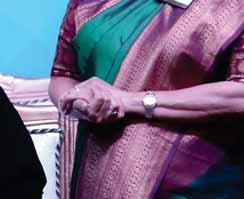








It
has been a roller coaster three weeks to say the least; I woke up on June 30 feeling very content knowing we were a simple happy family. We have two daughters — Ektaa and Samta — who are pursuing their Masters and we are a very close-knit family with simple pleasures and middle class values. What followed that evening (the meet where the couple were felicitated) was a real shocker; my husband Dakoju Ravishankar had donated `100 crore to The Rotary Foundation!





I had to pinch myself to realise it wasn’t a dream or hallucination when they called us to the stage to felicitate us. Ravi has always been a philanthropist in his own humble way; when I married him 30 years ago all he had was a Suvega (two-wheeler) and a rented house, but he had a heart of gold. In 30 years, he has built up his reserves by working hard. He has built an old-age home in Bengaluru in memory of his late parents who mean the world to him, which is run free of cost for people who are less fortunate. The quality of the home is unparalleled and the food and services fantastic.
He has also built schools with hostels in the Northeast where children don’t get an education due to lack of interest and rivalry between the tribes and families. Here too education is provided free or at a nominal cost with free boarding. These are only some of the avenues he has ventured into. But I know he has big dreams. Sometimes we wonder if he has worked all these years, and is still working, just to support these causes!
He is a workaholic and works almost 18 hours a day; he left last morning at 4 am for Malwan in Maharashtra via Goa. Came back this morning at 9 am and went straight to KGF (Kolar Gold Fields) where he is doing a massive tree plantation project on the Cyanide Dumps — to make the place liveable for the locals as the chemicals used in the gold fields have been detrimental to the health of the people there. He is trying to convert it into a green zone, facing health hazards himself going there as he was a chronic asthmatic. But his priority is to improve the lives of others.

and later became his partner. “The name of my company Hara Housing comes from Hari and Ravi. I wanted somebody honest and straightforward and not a smart and intelligent partner who would one day cheat me because he would soon realise I’m a simple man!”
A buffet called Rotary
So why did he join Rotary?
“Well, around 1988, when I was already in my business, I found everybody around me obsessed about the (realty) market and I felt suffocated… with the kind of people I was mixing with. Everywhere, even in a toilet, people would ask: ‘Sir, how is the market?’ Whether it was a doctor, barber or a dentist, they’d talk only about business.”
When he met a senior Rotarian, Ramesh Chari, “I told him I am fed up and am scared I’ll end up with a habit like drinking. I want to connect with society. He said why don’t
you try Rotary, and brought me into Rotary.”
Asked what Rotary has given him, Ravishankar says: “For me Rotary has been a learning experience. Rotary is like a buffet; it is up to you what you want to take from it. If you want to eat healthy, that is there, if not; the opposite is also there. For a recluse… and one who loves to chill out, it was a platform to connect with people and change lives. Rotary gives you the opportunity to do things.”
And the kind of “things” he has done from the Rotary platform are impressive indeed and range from building an old-age home in Karnataka to schools in the Northeast. He has also offered to build schools in rural areas in Lahore and Islamabad and has connected with the DGs in Pakistan, telling them he wished to do this “as we were all brothers before the Partition and share the same blood. When people connect, governments cannot
separate or stop us. Even if I have to do it on my death bed, I’ll do it… because in the name of religion, we are complicating our lives.”
A project he has on hand right now is planting one crore (10 million) saplings in Kolar and Chikkaballapur districts with help from Amar Narayan, a retired IAS officer passionate about trees and saving the environment. “I asked him can we work together; I always see myself as a co-worker, and not the president of my club. Every Rotarian is a leader: I cannot lead leaders, I can only work with them. He has agreed and we’re trying to rope in the State government. It’s a five-year project where we want to involve schools, donate plants and make the headmasters responsible for ensuring the trees survive.”
Society mantra Ravishankar, who calls himself “a freaked out human being” says that


On why he chose TRF to part with such a huge chunk of his money, D Ravishankar says, “I’ve grown up among cheats and frauds…
I’ve seen society naked and can differentiate between a pure and an evil person. Rotary is a transparent and honest NGO. People don’t like to donate because most money is hard earned and we find every other NGO is a fraud and misuses funds. But Rotary I know is a genuine organisation.”
He touches on another sterling quality of Rotary when he stresses that he is an areligious person who doesn’t “believe in the artificial barriers that religion and caste create — I go to mass on important occasions. I have three sisters, two are Muslim and one Gujarati, and “all of them tie raakhi on me!”
He adds, “I’ve given this money blindly with my eyes closed because the DG, Suresh Hari, is an honest man and I trust him completely.” He has stipulated the core areas on which his money should be spent, and these are education, health, hygiene and sanitation, tribal improvement, microfinance and inter-religious harmony. “Basically, all the components of Happy Schools.”
On whether he would monitor how his money is used, he says emphatically: “Of course. I will keenly follow how that money is used because every paise has been earned through hard work; I have slogged, my father was not a minister. I am very particular about it and wouldn’t even mind leaving Rotary if it goes into wrong hands.”


My daughter said, “‘Nana, follow your heart, give whatever you want, don’t worry about us.”
when his daughters Ektaa and Samta were very young — 9 and 5 or so —
“I’d always tell them I have taken so much from society, I need to give back. They said “Nana (father in Telugu), you do that. Don’t worry about us; we’ll study and stand on our own feet. Today they are 27 and 23.”
So, are both married? He laughs and says, “No, they want to get married only when they can stand on their own feet.”
The elder one, who has just left for her Masters course in Melbourne worked for a few years to save some money for her education and wanted to take a student loan. But on the counsellor’s advice didn’t do so and “wants to return the money she has ‘borrowed’ from her father by working part time there,” says her mother Paola.
Whether it is higher education or trekking in the Himalayas for which the younger daughter Samta recently needed to buy some trekking gear, they’re careful about the money they spend.
“We’ve brought them up that way,” says Ravishankar, adding, “we follow a simple lifestyle and are middle class by choice. In life, you have to balance… wanting is not bad, greed is bad. I have come from such a bottom that I wanted to give something nice to my wife and daughters. But all my clothes are from Reliance. My friends wear Armani but I am not bothered. I had always lived in a rented house till my mother told me one day: ‘Ravi, your father didn’t own a house. I think I will die in a rented
house.’ So I bought a house in 1997 to make her happy.”
Also, to express his love for his family he bought a luxury car. “Yes, it is a Benz, which I don’t want to buy ever again. From now on it will be secondhand cars, because it is just not worth it. With the car money I could have built three schools in the Northeastern States.”
He has already built a few; one for 350 students in Manipur near the Myanmar border investing `27 lakh in two acres of land and a retired army colonel running an NGO is managing it. “The tagline of this Trust is ‘Peace through Education’; he wants to stop the children in the Northeast from being influenced by insurgents.”
Another school Ravishankar has built is for children of drug addicts who are infected with HIV.
So philanthropy is inbuilt in his genes, I comment. “No, no, please don’t use big words like philanthropy… it is just simple giving away,” he smiles.
The 100-crore figure Next, I ask him how he zeroed in on the `100 crore ($14.7 million) figure and what was Paola’s reaction. He chuckles and says: “I am an emotional human being who is not getting younger. From childhood I have this trait; either I think big, stupid or impossible. My wife, being the mother of two daughters understandably had some insecurities, but my daughter convinced her

saying, ‘Mama, he has taken good care of us all these years. And this is Nana’s yolo (you only live once) moment, so please let him do whatever he wants.’ And she told me: Nana, follow your heart, give whatever you want, don’t worry about us.” With those words, she brought her mama on board!
no greed, and has never asked for jewellery. Even when she wears artificial jewellery, she looks like a princess. Her smile is the best jewellery she has.”
All my clothes are from Reliance. My friends wear Armani but I am not bothered.
His younger daughter, who will also shortly leave for higher education in Australia, for which she also has been saving money, “doesn’t even want to inherit our house. She says if you leave it for me, I will sell it and build a school in Kashmir with the money,” smiles Ravishankar, and adds, “I was so touched and felt so blessed to have such a fine family.”
“Finally, the majority won, and my wife was on board. She is a wonderful girl; no jealousy,
When I say his is the second single largest contribution to TRF after the Bill and Melinda Gates Foundation, Ravishankar says, “I didn’t think of any statistic, nor had a strategy in my mind. I simply decided to give.”
Quips Paola, “When someone like Bill Gates contributes to TRF, we say it’s fine; but when someone like Dakoju Ravishankar, who is literally a nobody, decides to give almost 70 per cent of his earnings to the Foundation, I guess we all have to sit up and say ‘Wow!’ I am still getting over the shock myself!”
Designed by Krishnapratheesh S


oronto came alive when 25,652 Rotarians descended in the city to network and celebrate friendship beyond borders at the 109th Rotary Convention. The event was the talk of the town and wherever you went, right from hiring a cab from the airport to a restaurant or in a train, you heard people say, “There is some Rotary event happening and people from various countries have come down to attend it. That’s why the rush…”
Even as I shuttled between the Air Canada Centre, the main venue for the


as main venue for the fr from om the he otthher e side of the he g o lobbe and n call hi him m his firrst st namme. e ”
plenary sessions, and the Metro Toronto Convention Centre a few blocks away, the venue for the breakout sessions and House of Friendship, I was never walking alone. There was always some Rotarian from another part of the world falling in step with me and starting a random conversation, either about his visit to India or sharing an amazing Rotary moment. RIPN Mark Maloney’s remark was bang on the mark: “Rotary lets you sit down next to a total stranger from the other side of the globe and call him by his first name.”


Toronto is second only to Chicago in the number of conventions hosted. This is the fifth Rotary convention to be hosted in this city, the first was 94 years ago, with subsequent conventions in 1942, 1964 and 1983.
The 2018 Convention began with a colourful flag march representing 178 countries, after which RI President Ian Riseley presented Norah Owori and her son with a posthumous Rotary International Award of Honour for the late RIPE Sam Owori. PRID Gordon R McInally

RI President Ian Riseley presents the RI Award of Honour to the former Prime Minister of New Zealand Helen Clark.



was the Convention Chair and PRID Safak Alpay, the Vice Chair. Riseley’s heartwarming speech summed up the year gone by and acknowledgements for the Rotarians who walked with him in his presidential journey. “I am an accountant, and we, accountants love a good balance sheet. But in Rotary, at the end of the year, we want to see not an account balance, but a world that is better than it was at the beginning of it — one that is healthier and happier, and, perhaps a bit more peaceful as well.”
Referring to the RI President’s office on the 18th floor in Evanston, he said that though the view from there was impressive, “the number of days I got to look at it were very few indeed. Most of this year Juliet and I spent not looking down upon the Rotary world, but looking it in the eye. We saw the difference that is being made by Rotarians around the world, every day — a difference multiplied and magnified by the 1.2 million members, serving in over 35,000 clubs, worldwide.”
Though planting trees is a longestablished Rotary tradition, right from the days of Paul Harris, “this year, we planted trees not only for friendship, but to draw attention to the urgent need for Rotary to include the environment in its service activities. We should be paying more attention to protecting our planet, and ensuring its sustainable future,” he said, having visited 60 countries and planting 180 trees world over during his year.
“Our values define us,” he said, borrowing a line from an advertisement that he came across for a bank during one of his travels. “The Four-Way Test, Service above Self, our motto — those values must be defended, and preserved, by all Rotarians through whatever changes we may choose to embrace in Rotary. They are what makes Rotary special, and what makes us different.”

Striking a poignant note at the closing session, he thanked all the Rotarians for making his year meaningful. “It is striking how little significance each individual role has in Rotary. You can’t do a Rotary project alone, you can’t become a Rotarian alone, and it often seems that no decision in Rotary is ever made without a committee. We leverage our contributions to do more together than we ever could do alone, to make a difference and it is vital that we be the inspiration,” he concluded.
“Challenge yourselves to be the agents of change. Your enthusiasm should be contagious enough to bring in more Rotarians to Rotary,” said RI President Elect Barry Rassin in a passionate address which covered Rotary’s partnership with the Haitian government to provide water to every citizen of the water-starved nation. He described how his theme — Be the inspiration — can be acted upon to inspire Rotarians, non-Rotarians, Rotaractors and the younger generation. He stressed at leveraging the social media “to show, and not just tell, the world what we do and who we are, every time we help humanity.”
Rassin’s main focus is to build Rotaract “in a strategic way. We have 250,000 Rotaractors and 10,000 Rotaract clubs around the world. But only a tiny percentage of Rotaractors join a Rotary club. Only 27 per cent Rotary clubs sponsor Rotaract clubs. We need to double all these numbers.” Rotary needs younger members, younger leaders to stay strong. Rotaract is the vital force of Rotary. For the first time, a select few DRRs will have the opportunity to participate in the 2019 International Assembly, he announced, to huge applause.
Spelling out the new vision statement: Together we see a world where people unite and take action to create a lasting change — across the globe, in our communities, and in ourselves, he said, “That is Rotary, in one sentence. We are people of action, we are not thinkers or dreamers, we are doers. Our vision statement tells the world what our ultimate value is for the long term and helps Rotarians and non-Rotarians understand what our goal is when it comes to changing the world.”
He highlighted the importance of building sustainability in every project and initiative Rotary clubs and districts
conduct. And urged every Rotarian attending the convention to “take home the inspiration you have gathered here, and awaken in the soul of every Rotarian a longing for a better world, making the future better for our children.”
For RIPN Maloney, Toronto holds great significance as it was his mother’s home city, and he attributed his “booming radio voice” to her, a radio actress with the CBC during her teenage years. In his acceptance speech, he stressed on the need for “people of all ages, not only to serve, but also to lead. We must have clubs and membership models that embrace today’s families, societies and expectations.” Calling for a greater involvement of Rotaractors, he said that Rotary’s first partnership will be with Rotaract.
RI General Secretary John Hewko shared his personal story of how his parents came as refugees to the US from Ukraine at the end of World War II.
“As a child, they would tell me stories of leaving everything behind and making the long and dangerous trek from western Ukraine, across war-torn Europe, to the refugee camps in southern Germany — and then to a new life in the US. In fact, it was my desire to give back to the country that welcomed my parents with open arms that motivated my interest in public service.”
The delegates were treated to a host of eminent speakers and world leaders discussing various aspects of Rotary’s six areas of focus. Haitian Prime Minister and Rotarian Jack Guy Lafontant announced the creation of HANWASH, a collaboration between Rotary and his government to tackle the nation’s water and sanitation challenges.
UK’s Princess Anne lauded Rotary for taking a central role in the eradication of polio.
Highlighting women power
Former first lady of the US Laura Bush stressed the significance of education
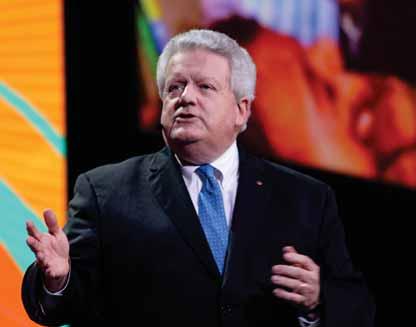
in shaping a child’s life and placed great importance on women’s empowerment and economic independence. “Your work — to fight disease, provide clean water, support mothers, advance education and promote peace — makes a brighter future for our children and I am deeply grateful for your service,” she said, adding that there are so many needs to be met and so many ways we can all help.
A discussion between Riseley and Helen Clark, former prime minister of New Zealand and one of the architects of the United Nations Sustainable Development Goals, centred around gender equity and the crucial link between environment, poverty, hunger and peace. To a question by Riseley on how she felt about “smashing the glass ceiling” when she came into politics at a time when women in politics was a rarity, Helen said, “When I was elected to the Parliamentary Party in 1981, there were 92 MPs of which eight were women and people started saying that women are taking over!”
This despite the fact that New Zealand was the first country where women fought for the right to vote 125 years

ago. She concluded with conviction that the tenth Secretary-General of the UN will be a woman and she will support the strongest candidate.
Riseley presented Helen with the Rotary International Award of Honour in recognition of her commitment to inclusion, equality and work for a sustainable future.
Other speakers included Dr Tedros Adhanom Ghebreyasus, Director General of WHO, Dr Caryl M Stern, President UNICEF-USA and Ann Gloag, Founder of the Freedom from Fistula Foundation.
The convention also celebrated Rotaract’s 50 th anniversary and a panel discussion with Rotaractor-turned-Rotarians was moderated by RIDE Olayinka Hakeem Babalola, a past DRR.
The Rotary Alumni Global Service Award was presented by Riseley and TRF Trustee Chair Paul Netzel to John Caulfield, a career diplomat and an Ambassadorial Scholar sponsored by RC Moorestown, New Jersey, USA, in 1973–74.
Designed by N Krishnamurthy

Rotary has a long history in China that dates back to 1919 when the first club in China (and the second club in Asia) was chartered in Shanghai. This first English-language club mainly had expatriates — Americans and Brits — but it soon took on an international flavour as it welcomed other nationalities to its roster including prominent local Chinese businessmen.
Rotary flourished in China and 33 Rotary clubs came up throughout the mainland up to the Liberation in 1949. After 1949, however, it became impossible for Rotarians to meet and many members moved overseas. The remaining clubs were formally disbanded by Rotary International in 1952.
But from 2006, Rotary clubs are being revived one by one. Shanghai West was given provisional club
status again in Dec 2014 by RI. The Charter was presented in May 2015 by RI President Gary Huang and RC Shanghai West is the first Mandarin Chinese language club on the mainland, since 1948. It follows in the footsteps of the original Shanghai West Club that was chartered on Nov 16, 1948.
Because of China’s unique characteristics it has been treated by Rotary like a small de facto district under the leadership of a Special Representative to China, who is their de facto District Governor. During a recent visit by 20 Rotarians from RC Madurai West to Shanghai, we had the opportunity to meet the current Special Representative Rtn Frank Yih, Past President of the Rotary Club of Shanghai. The Charter President of RC Shanghai West Rtn Richard will be the Governor for 2018–19.
The Rotarians of RC Shanghai West gave a very warm and rousing welcome to our members. Their reception team comprised Rtns (Evan) Tsung-Han Huang, the President; Chao Yin Cheng, the Secretary; Richard, their Charter President, current AG and incoming DG; Rtn Emma, the Programme Chair; Gill Hsu, Roy Chu and the affable Lynna Wong, Vice Fellowship Chair. Rtn Lynna Wong also known as ‘Coffee’ (owns a coffee plantation in Indonesia) put all of us at ease and acted as an interpreter.
Both the Presidents Rajkumar and Evan Huang exchanged club flags and gifts. All our members were overwhelmed by the warmth of our Rotary friends beyond the Great Wall.
The writer is past president of RC Madurai West, D 3000.

TRF Trustee Chair
Paul Netzel







Thanks to your generosity and that of Rotarians around the world, we have raised a new one-year alltime record of $372.6 million for our Foundation,” said TRF Trustee Chair Paul Netzel, amidst thunderous applause as he delivered the keynote address at the Toronto Convention. This was in response to a comprehensive fundraising goal of $360 million, the top two funding objectives being $150 million for Polio and $135 million for the Annual Fund.


He recalled that last year when TRF celebrated its centennial, the target of $300 million was met with $304 million. He added that even though some thought the amount collected this year would be lower after the success of the centennial year, TRF Trustees were determined to prove that 2017–18 being the first year of The Rotary Foundation’s second century, a higher goal should be set and met. “They believed that you Rotarians would respond to the challenge, because the needs around the world are more pressing now than ever.”

The Foundation has invested more than $4.4 billion in humanitarian projects over the last century and over 85 per cent of the districts worldwide are participating in global grants. Nearly 1,200 global grant applications have been approved this year, including 487 district grants, involving 168 countries.
Marvelling at how the Foundation has adapted itself with various services to a rapidly changing world, he looked back at the decades gone by — the Institutes for International Understanding launched in the 1930s; the scholarship programmes for graduate study in the 1940s which “even earned us a seat at the table at the 1945 San Francisco Conference where the United Nations Charter was signed.” The 1960s saw international partnerships between clubs/ districts. In the 2000s, the Rotary Peace Centres began equipping students from all continents for careers in peacebuilding, conflict prevention and resolution. “And, today, this programme has 1,162 graduates, with 100 new Rotary Peace Fellows being added each year. We will be adding four new peace centres over the next decade,” said Netzel.
On Rotary’s momentous role in polio eradication, he pointed out how Toronto supported this milestone achievement. When in the 1950s Dr Jonas Salk first developed the vaccine against polio, he did not know how to mass produce the vaccine for large-scale distribution. “But here in Toronto, a Canadian scientist, Dr Leone Farrell, was working on what is now referred to as the ‘Toronto Method’ to produce the vaccine in large quantities.” She pioneered a method of vaccine production by gently rocking cell cultures to stimulate the polio virus growth. This helped Salk’s serum to successfully immunise 1.8 million children in the US, Canada and Finland during 1954–55, making this the largest medical experiment in history. While Dr Salk appeared on the cover of the Time magazine, Dr Farrell faded into relative obscurity. “Like her, we have so many unsung heroes in our fight against polio whom we remember today through two ways; first we can honour their legacy by delivering a polio-free world; second, we can build Rotary’s future by getting ourselves ready for a post-polio era.”
Ihave Rajashree Birla as
Paul Netzel TRF Trustee Chair
n the last one year, Rotary and several global leaders pledged $1.5 billion to end polio, with Rotary’s pledge being for $450 million. “We are very near to achieving this year’s $50 million goal and to this we will have the Bill and Melinda Gates Foundation’s 2 for 1 match of $100 million contribution to TRF.”
He highlighted the generosity of Rajashree Birla, Chairperson of the Aditya Birla Foundation for Community Initiatives and Rural Development, who had recently contributed $1 million to the Polio
Prime Minister Trudeau has committed Canada to remain a strong partner until polio is completely eradicated. We promise to continue to make
Ian Riseley Rotary International President
Fund taking her total giving to $11 million. “We are so fortunate to have her as a donor from a country that has been polio-free for over five years.”
Referring to TRF’s ambitious aim to build an Endowment of $2.025 billion by 2025, Netzel said that when that happens, the Foundation can reasonably anticipate receiving — in today’s dollars — approximately $100 million each year from investment earnings. These funds will ensure that future Rotarians will have the resources they need to design and implement projects to make a difference.
On a sober note, he recollected his visit to India, as district governor, to provide corrective surgeries for polio survivors when he was moved by the gesture of a 9-year-old polio victim Pareekh and his parents. “I was speechless and time virtually stopped for me when they bent and touched my feet. The next time you think about the level of your gift to our Rotary Foundation, please think of the Pareekhs of the world. Thank you!”

One of the highlights of the day was the conferring of the Polio Eradication Champion Award to the Canadian Prime Minister Justin Trudeau by RI President Ian Riseley and International PolioPlus Committee Chair Michael McGovern.
Although Canada got rid of polio 20 years ago, the country has supported the cause with CAD $750 million, including a $100 million pledge for global eradication of polio in 2017, and $20 million for polio eradication efforts in Pakistan. In early June, Canada, as host of the G7 summit, was joined by G7 leaders in affirming commitment to polio eradication.
Canadian Rotarians have contributed $66.6 million towards polio eradication, besides travelling to polio-afflicted countries to participate in mass vaccination campaigns.
Canada was the first government to join Rotary to work for a polio-free world. “Prime Minister Trudeau has committed Canada to remain a strong partner until polio is completely eradicated. We are grateful for your nation’s long-standing support for this historic endeavour. We promise to continue to make every effort to benefit the world’s children now and forever,” said Riseley.
In his acceptance speech, the Prime Minister said, “Wherever you go in Canada, the word ‘Rotarian’ makes people think of service. That’s because the work you do every day adds up to something incredible. Sixteen million volunteer hours every year… congratulations. Not only has Rotary spent over $2 billion, you have also put
pressure on the governments to create change. So while receiving the Polio Eradication Champion Award, I want to thank you all too.”
“Your fundamental principle of Service above Self doesn’t just describe your dedication. It shows the world what everyone can do when we come together. I want our kids to grow up in a world without polio. I want a world where gender equity is a reality and everyone has the chance to succeed. Together I know we can work hard and build a better world. Thank you all. Merci beaucoup!”
Trudeau is the third Canadian Prime Minister to receive the award, joining Prime Ministers Jean Chrétien and Stephen Harper. Past recipients also include Shinzo Abe, Prime Minister of Japan; Angela Merkel, Chancellor of Germany; Xavier Bettel, Prime Minister of Luxembourg; Muhammadu Buhari, President of Nigeria; Nevin Mimica, European Commissioner for International Cooperation and Development; and Ban Ki-moon, former UN Secretary General.
Pictures by Mike Thorn
Designed by N Krishnamurthy Service above Self

Kiran Zehra

Preparing three months in advance before her installation as the president of Rotary Club of Hyderabad Gachibowli, D 3150, T S Sashikala knew exactly how she wanted to start her Rotary year. The icing on the cake was the presence of RIDE Bharat Pandya, who wants to encourage women’s leadership in India, and hence decided
to participate in her installation. “We are grateful to PDGs Sam Patibandla and TVR Murthy who invited him on our behalf,” she adds.
Girl students “with good attendance and academic records,” were identified and shortlisted by members of the club to receive bicycles. “Despite the fact that these girls had to walk 7–8 km to reach
school they attended classes every day. Such dedication deserve appreciation and more,” says the President. The total cost of this project was ` 45,000. Not only this, “we also identified women from weaker economic backgrounds who worked part time at sewing factories,” and in order to help them double their income the club distributed six sewing
machines at a cost of ` 30,000.
The club has been involved in projects that support girls’ education and women’s empowerment projects since its inception in 2008. “Forward thinking and service minded,” are the qualities of the “members in our club and we work together without any discrimination,” she adds


This reunion of the governors of 1991–92 is a gesture of appreciation and gratitude for the strength and support provided by PRIP Raja (Saboo). We look forward to this opportunity to come together because of the special values that we share with our president and we love to do it every year. Here is to the class of 1991–92,” said Louis Marciano, a 1991–92 PDG from the US and Event Chairman, raising a toast to PRIP Rajendra Saboo and spouse Usha.
The lunch was held at the Toronto Convention to celebrate the reunion of the class of governors of 1991–92 when Saboo was the RI President. The guests included PRIP K R Ravindran and Vanathy, RI President Barry Rassin and Esther, RID C Basker and Malathy, PRID Y P Das, PRID John Boag, and past governors, including from Saboo’s home district 3080. While Ravindran and Rassin were governors, Basker and Toronto Convention Chair Gordon R McInally from Scotland were club presidents, recalled Saboo. RIDE Olayinka Babalola

(Nigeria), who was also present, was a Rotaract Club president then; “this shows how old we all are!”
Every year this event is held on the sidelines of the Rotary Convention. The camaraderie and warmth amongst the past governors and the senior leaders and their love and respect for
Saboo were palpable at this intimate gathering.
A reunion that became a fundraiser
The reunion meet is special in more ways than one. “There is an interesting story to it,” said Ravindran. In 1998,

Saboo and Usha had invited a few PDGs, including Ravindran, to their home in Chandigarh and had booked a train journey for them from Delhi.
“During the journey, we were breaking our heads as to what to gift the couple. And Lou (Marciano) came up with a brilliant idea. He said, let’s pool some funds together and give it to them. Let them use the money however they want, maybe they’d want to put it in a service project.”
So the 20 of them contributed $50 each, and another guest gave $20, making it $1,020. The Saboos appreciated the gift, and recommended this idea be extended to all the 1991–92 governors world over. He suggested Marciano communicate the idea to the past governors to raise $25,000. “I was totally in a fix. I asked him, how am I supposed to do that? We have 6,000 languages in Rotary and how am I to communicate to them all?” I told Raja (Saboo), to which he just replied, ‘Don’t worry about that. You can do it.’ God bless my wife, Gloria. She said, Lou, I will help you on the job,” related Marciano.
Saboo got the letter translated in various languages and Marciano and his wife mailed the letters.
“The very first cheque we got was for $20,000 and the next was for $1,000.” Ravindran sent several cheques totalling to $25,000–30,000. “Even PDG Ravi Vadlamani and his wife Raji (Rajyalakshmi)… they are not members of our class… send a cheque for $1,000 every year for the past 6–7 years,” he added. To honour this gesture, the Vadlamanis were made honorary members of the class.
Over time, the funds swelled to a considerable value, enough to sponsor four peace fellows — one each in 2002, 2009, 2014 and 2018 — at the Rotary Peace Centres. Three of them have passed out and one is soon graduating. Ravindran added, “Thanks to this train carriage fund we started then, the present gift value of this fund is $561,804 and the market value is $740,846. Beginning small, we have arrived at a considerably large figure and we should continue to grow this fund to at least a million dollars.”

Rassin, recalling how Saboo involved the governors to take Rotary effectively to every district, said, “When we have our community together we can collectively move any boulder along our way to make our world a better place.” Serving as aide to Ravindran, he added, had given him insight into what it takes to be a world president. “I wish I could be as good a president as Raja and Ravi,” he added.
He asked of all club president to make themselves more enticing to the younger generation. “This is an era for us to start ringing in a radical change. Each club needs to consider what the future is and how we are going to get there.” Each club must bring a dramatic transformation to make sure it is a vibrant, strong club that Rotarians want to go to. “I ask you, especially this class, that each one of us must look beyond ourselves and be the inspiration to others around us, to our friends and communities, so that we can make sure everybody wants to be a part of what we want.”
Saboo, in a mellow mood, thanked the delegates and said, “Until I gave my first speech in the International Assembly back in 1991, I thought: will this short man from a developing country like lndia be accepted in the hearts of Rotarians from the rest of the world? Then when I spoke about my theme, I understood that I have forged a relationship — they belong to me and I belong to them. That is when I realised that 1991–92 will be a year to be remembered for all us. I do hope that we be given the years to serve and continue to meet at the Reunions and also do our bit to renew the contact so that we draw inspiration from each other. God bless you all.”
Pictures
by Jaishree Designed by N Krishnamurthy


Prof Malay Mukhopadhyay is a passionate potamologist (one who is an expert on rivers and researches rivers).
A professor of Geography at the Visva Bharati University, he has trekked along five rivers, including River Thames in London, to raise consciousness about the importance of rivers in our lives and how people living around these rivers should take care of them. In December 2017, after intensive research, aided by his research scholars, he headed a 40-day 110 km-long trekking expedition along the Kopai river.
“He looks at rivers as living embodiments and any harm done to
them is painful to him. He is a charter member of our club RC Tagore Land, which is nestled in the bosom of Santiniketan, the abode of peace where Nobel laureate Rabindranath Tagore started the Visva Bharati University. The club has many professors from the university as its members, and he undertook this unique project to focus people’s attention on the degradation of rivers,” says PDG Ashok Kumar Agarwal from RID 3240.
Under the professor’s leadership, some of his club members, colleagues and students and some German visitors



undertook a week-long expedition to trek from the source of the Kopai River to its confluence with the Mayurakshi River, a distance of 110 km. Kopai is a small river flowing in the north of Santiniketan, originating from the foothills of the Chotanagpur plateau in the west and flows east ultimately to surrender its identity to the Mayurakshi River.
On why he chose the Kopai River, Prof Mukhopadhyay said that the great poet Tagore was very fond of this river. “It was he who changed its name to the present Kopai because it was prone to flooding and people



were very scared of the floods. But it also had a lot of water for irrigation and the local people conducted a lot of rituals at this river.”
In fact, so enamoured was Tagore with the Kopai River that he wrote about it: “ Amader chhoto nodi chale anke bankey, Boisakh masey taar hantu jal thakey (Our small stream moves forward in bends and curves In the month of Baisakh it only has knee-deep waters).”
Another reason for Tagore’s enchantment was the scenic beauty of this river and he had invited the famous potamologist Dr Arthur
Gedes to study this river. “When I joined the Visva Bharati University some 30 years ago, I started researching the river and sometime later trekked along this river with my wife and daughter Gayatri, who was then only 3 years old, and her name is there in the Guinness Book of World Records,” says the professor.
Explaining the organisation of the trek, Sanjukta Banik, Prof Mukhopadhyay’s research scholar, said the trek had about 40 permanent members, of whom half a dozen



Whichever village we visited, we got such warm hospitality that it felt like the villagers were celebrating some kind of a festival. They brought us tea, food and tried their best to help us if we had any problem.

Prof Malay Mukhopadhyay leading a team of research scholars along the Kopai River.

were women, who trekked the entire 110 km distance. There were seven German associates of the professor who also joined the expedition. Others joined it at different points for a journey of a day or two and there were about 15 to 20 women in this category. During this 8-day trek, which was very flexible for its participants, the group stayed in tents on or near the banks of the river near eight different villages and tried to make the villagers aware of the importance of keeping the river clean and alive.
Describing the trek and the participation of women as well as the challenges the trekkers faced, she said that the major challenge was that each day a distance of 30 km had to be covered and “we had participants aged from 4 to 82 years. From my point


of view this was the biggest challenge; the 82-year-old was Professor Mukhopadhyay’s elder brother.”
At night the trekking group halted in villages in makeshift tents, “and we slept in sleeping bags.” For their toilet needs the women didn’t face much of a problem “because in most places we pitched our tents on school grounds and used their toilets. Sleeping in schools also provided us the safety feature,” she added.
Prof Mukhopadhyay said one night was spent on the campus of their Rotary club, where some 13 tents were pitched.
The group put a marker stone at the source of this river in the village called Khajuri. This marker stone has Rotary’s emblem prominently displayed. “The trek not only created



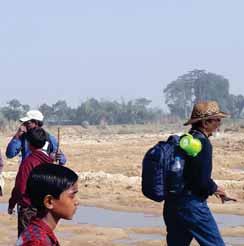






awareness among the different villagers about the importance of river in our lives but also how to save it from degradation. It also created ripples in the minds of Rotarians who trekked along its path as how human greed is destroying our environment and what nature has gifted us,” says Prof Mukhopadhyay. On his invitation some Germans from the NGO Indian Helfie also joined the trek.
Warm reception
Sanjukta adds that the team was overwhelmed by the reception they got from the villagers. “That was the best part; whichever village we visited, we got such warm hospitality that it felt like the villagers were celebrating some kind of a festival. They brought us tea, food and tried
their best to help us if we had any problems.”
But then quite a few members of the team were familiar with the villagers because about six months before doing this project, Prof Mukhopadhyay and a few of his students, including Sanjukta, had done a recce survey along the river, “visiting all the villages and marking our stops for day and night halts and interacted with the villagers to know their perception about the river,” she adds.
On why this particular river was chosen for the trek and if it was dying, she says, “Not really; Kopai is a very unusual and small river, being only 110 km long. This river was chosen because our professor had conducted a trek along this river 25 years ago in 1991; 2017 was the silver jubilee

Some villagers remembered that many years earlier a professor had installed a stone to celebrate the river. They couldn’t recognise him but the professor was thrilled and said preserve our natural resources do not go unnoticed.
of that trek so he wanted to honour the river by walking along it with a group of people.”
Asked if there was enough water in the river, she says that parts of it have totally dried; and there are some malpractices which are being carried out at some points. “For example, near Santiniketan, we found that people are concreting the entire river bed.”
An interesting insight this PhD scholar shares is that the women’s perception and attitude towards the river is quite different from that of men. One part of her assignment was to do a research survey on the village women’s perception about rivers.
“I found from the women that earlier the Kopai River was a part and parcel of the entire village’s life. But now the villagers are moving away from the river. They are no longer dependent on the river and visit it only once or twice a year for some religious purpose or a ceremony. Apart from that, they have no other attachment with the river which is very sad.”

The team revisits the marker stone installed by Prof Mukhopadhyay 25 years ago.
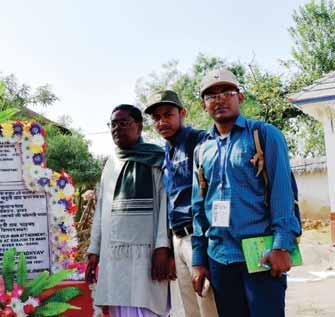

Also, she found that near the source of the river people are totally away or detached from the river; “but as you go along the flow of the river, their attachment increases, but even then it is meagre compared to what it once used to be.” Talking to villagers, she also found that women are more emotionally attached to the river than men. “The men are very happy because they get 100 days’ work from MNREGA and similar schemes to lift sand from the river bed or some construction work and it doesn’t bother them much that the river is dying or drying out. But on the other hand, I found that women really feel sad about the dwindling of the rivers. They were telling us stories from their childhood on how the river used to flow with its full might and how now parts of it have dried out. Women definitely have more feeling toward the river… .”
An integral objective of this trek was to identity some tourist and heritage points along the river — small temples and other tourist spots of historic or cultural value.
A high point of the trip for this group of river aficionados was reaching the point where Prof Mukhopadhyay had installed a marker stone 25 years ago, just as he had seen being done at River Thames. “This is a stone which recognises the source of the river at a particular point in Jharkhand and when we reached that point we were all very excited to meet some villagers who remembered that many years
ago — 25 to be exact — a professor had come and installed such a stone to celebrate the river. They couldn’t recognise him of course, but the professor was thrilled that even after 25 years his trip was remembered, which meant that such efforts to preserve our natural resources do not go unnoticed,” said Sanjukta.
Prof Mukhopadhyay said an integral objective of this trek was also to identify some tourist and heritage points along the river — small temples and other tourist spots of historic or cultural value — which have been listed and a report is now being sent to INTACH, which had sponsored some parts of the journey.
Next on his agenda is trekking alongside River Ajay and that too will mark the silver jubilee of this potamologist’s return to that river.
Designed by N Krishnamurthy

Want to lime?” That was first question from my Trinidadian guide.
“Lime? No.” I certainly wasn’t nauseous after the 14,330 km-flight from Goa to the Port of Spain.
“Can yuh grease yuh waistline?” Popped another question. Were my ears ringing? I know CNN ranks Trinidadian accent as the world’s 10th sexiest accent, but who greases a waistline? My midriff is no motor nor rosewood furniture that calls for a regular grease. “All right, we’ll dig
into buss up shot for dinner?” The guide nonchalantly threw another Trinidadian term and my mind got further addled in Port of Spain, a tiny squiggle in the Caribbean Sea that began life as a mudflat before being crowned the capital of the twin islands of Trinidad and Tobago (T&T).
That night in Trinidad, I accumulated slangs. ‘Lime or liming’ is a synonym for ‘a gathering’ or ‘to hang out’; ‘grease the waistline’ is supposed to mean a dancer’s hips moving so fluidly that it seems that



Preeti Verma Lal
they were oiled; and ‘buss up shot’ is a flatbread that is rolled, folded, and torn to give it a messy, flaky texture resembling a torn-up t-shirt.
I could add bess (sexy), hadda (have to), wuh yuh (what are you?), cunumunu (a stupid person) to my slang laundry-list. But I chose instead to pick words off a Nobel laureate. The man who spent his childhood in the Trinidad capital before leaving for Oxford in 1950. My first images of Trinidad were borrowed from this man’s narrative. Of a house crowded




with superstitious men and crabby women and a man’s desperate quest for his own house. It was in Sir V S Naipaul’s famed novel A House for Mr Biswas that I first saw Trinidad.
That ‘house’ might be fictional but the white house which was once the family home of T&T Guardian writer and author Seepersad Naipaul and wife Dropatie (V S Naipaul’s parents), still stands in the capital’s St James’ neighbourhood. Naipaul no longer lives in Trinidad and his childhood home looks desolate. The lock









clasps the iron gate, glass windows are shut tight and black electric wires hang menacingly over the balustrade. The quietude is belying — it is unnerving to imagine a complicated narrative unfolding behind the white walls. But Naipaul lovers manoeuvre their way through the one-way street to pay homage to the Nobel laureate. Words of a writer are not the only solace in Trinidad, the southernmost
island of the Caribbean that sits coquettishly close to Venezuela (11 km). The earliest settlers were Amerindians who named it lene , the Land of the Hummingbirds. They considered the hummingbird holy and anyone who killed the bird was assured a place in hell. Even today the hum of the hummingbird lends a musical score to Trinidad. In the Yerette Hummingbird Sanctuary (Maracas Valley), hundreds


of hummingbirds flit in and out sipping nectar from the red feeders in Theo and Gloria Ferguson’s plush home. Of the 17 species of hummingbirds, at least 13 can be found in Yerette. They chirp and flit in such haste that it is difficult to catch the iridescence of the yellows, greens and blues of their feathers.
The chirp of the hummingbird can get drowned in the oompah beat of the steel pan, the only musical

Annatto is an orange-red condiment and food colouring derived from the seeds of the achiote tree.




The heavily pregnant Mommy turtle was digging deftly with egg-space was large enough, she laid nearly 100 softshell eggs, covered them with sand and swam away. Never to return.



instrument invented in the 20th century. Many decades ago, someone picked a 55-gallon chemical container and hit the first note. The twang must have enthralled the pan player. Soon, the hearts of the discarded gallons were beaten hollow to create music with rubber-tipped straight sticks. The percussion was so alluring that Trinidad soon had deft pannists creating an orchestra out of industrial drums. Today, Trinidad is synonymous with steel-panning where steel bands re-interpret the year’s calypso for carnival performances. Another musical

genre born in Trinidad is Chutney Soca, a form of music that combines English, Hindi, Hinglish and Bhojpuri to create an unusual melody and lyrics, a combo of calypso with Indian musical instruments.
One night in Trinidad, I wanted to leave music behind and court silence. The silence of a dark night in Matura Beach to watch the rare leatherback sea turtle swim ashore from the Atlantic Ocean and lay softshell eggs in the warm Trini sand. One of the

Rapper, songwriter, and singer Nicki Minaj was born in St James and lived here until she was five years old with her grandmother before moving to New York City with her parents.
Trinidad and Tobago is the only country whose capital city is named after another country: Port of Spain.
Pitch Lake in Trinidad is the world’s largest natural asphalt deposit covering almost 100 acres 245 feet deep.
largest sea turtles, the 800-pound leatherback has called Trinidad its home for millions of years. That night in Matura, I walked barefoot carrying a red torchlight in search of the heavily pregnant Mommy turtle. She was digging deftly with her rear flippers and when the egg-space was large enough, she laid nearly 100 softshell eggs, covered them with sand and swam away. Never to return. The baby turtles will hatch in 60 days. The Mommy leatherback will never see them. But in Trinidad, the baby turtles are safe. Protected under a massive conservation programme.
“Trinidad may seem complex but to anyone who knows it, it is a simple, colonial, philistine society,” V S Naipual wrote. Near the world’s largest traffic roundabout at Queen’s Park Savannah, I bickered with the Nobel laureate. Yes, Trinidad is colonial, it is simple but it is not philistine. You stand corrected, Mr Naipaul.
Pictures by Preeti Verma Lal
Designed by N Krishnamurthy


During a visit to the Civil Hospital, Pradeep Narula, President of RC Rewari
Main, D 3011, and Secretary Arun Gupta were moved by the sight of a number of mothers breastfeeding their infants in the open area of the Out-Patient Department. “Some hid themselves behind their saree pallus , while others turned away to
V Muthukumaran
feed their babies as they were embarrassed to do this in an open area. At that moment, we decided to do something to lessen the discomfort of lactating mothers who are visiting the hospital,” says Gupta.

To provide privacy to mothers breastfeeding their babies, “we have installed a spacious cabin (10 ft x 9 ft) at the OPD area of the hospital under Project Matritiv Kaksh.”
The maternity room can accommodate six women at a time and is fully furnished with curtains to provide privacy. Apart from providing free disposable nappies, the hygiene room is decked up with a series of mother-child pictures with messages such as the right way of feeding the newborn, how to hold it and how to manage a troublesome child. “Our focus is on facilitating proper bonding between a mother


and her child. The ceiling fan has cartoon pictures like Chotta Bheem and Micky Mouse to amuse and entertain the infants,” says Gupta.

The cabin is embellished with a number of toon posters and pithy messages in Hindi, on caring for infants with dos and don’ts. “Whenever we visit the hospital, we notice the cabin is always occupied and it makes us happy that the mothers are making the best use of it,” says Narula. While inaugurating the maternity cabin, DG Ravi Choudhary complimented the club for executing an innovative and need-based project “that will be of immense help to lactating mothers.”
While the club has spent around ` 80,000 for setting up the feeding room, its Secretary Arun Gupta is open to setting up such special cabins for lactating mothers at public places like the railway station and bus terminus in the near future.

Designed by N Krishnamurthy











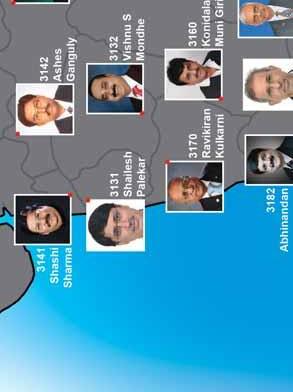


















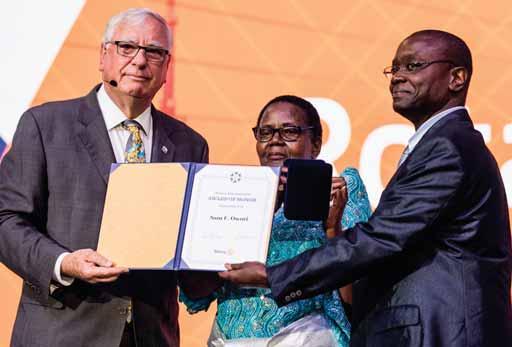
TRF Trustee Sushil Gupta and Vinita being introduced. Also seen in the picture to their right are Trustee K R Ravindran and Vanathy.



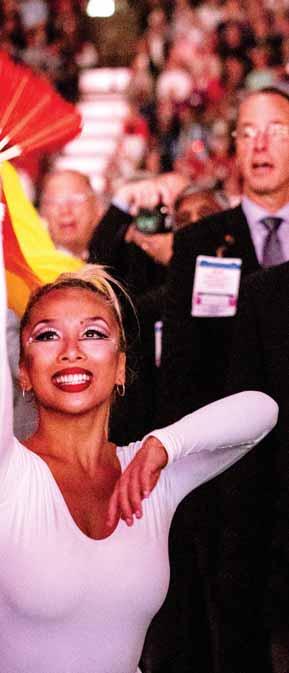



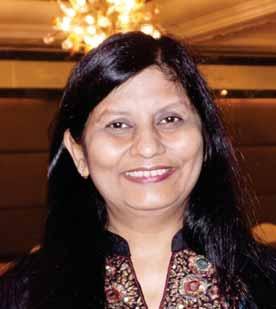
Microtunnelling and Waste Management, RC Baroda Metro, D 3060
When asked if her profession — microtunnelling — isn’t a bit unusual for women, Pinky Patel smiles and quips: “I’ve always loved challenges.” Well, getting into the ranks of the too few and far between women who have made it to the post of district governor in Rotary in India must have certainly been one such challenge. Another challenge she is giving herself is to get an additional 1,000 members in her district which has 102 clubs and over 4,300 members. And hidden in this challenge is yet another challenge; she wants at least half of these to be women members!
Pinky’s priorities this year as governor will be Literacy, women’s empowerment and health and hygiene for women. She joined Rotary in 2001 “because I wanted to do something for society, which individually I couldn’t have done.” Asked what kind of reception she got from her club members when she joined Rotary 17 years ago, and that too as the first female member of her club, she says, “Initially, they were a little apprehensive, but that lasted for a very short time.” Interestingly, she adopted a smart strategy to get “accepted” quickly by the male Rotarians. “I would attend the club meetings regularly, arrive on time as the meet began and left immediately after dinner… I gave the men the space I thought they needed.” Her strategy worked and “they accepted me once they realised that I am not a woman who thinks she should be treated in a special way. I remained the sole woman member of my club for four years!”
So what has Rotary given her? “Oh Rotary has given me a lot of things; a platform to work for society and my personality is totally transformed. I am so much different from what I used to be, with much more patience, certainly more confidence and better management and leadership skills.” Rotary has also taught her, she adds, to look at things from other people’s viewpoint.
So how difficult was the ascent to the post of district governor? “Honestly, I didn’t really find it all that difficult. See, once a woman doesn’t have the attitude that just because I am a woman I should be treated differently or given more attention, then people accept you easily… and are very positive and friendly.”
Her TRF target? “I have set a very high target for myself and my district; I want to collect over $1million, a figure we have not touched so far, but I am confident I’ll do it.” she says. And that, because “I am a woman and find it easy to ask for money I will simply tell the Rotarians: Please give me the money; I need it!”, is her parting shot.
He joined Rotary in 1992 with the sole objective to do good for the community. “From my childhood I have grown up imbibing my family values to do good to mankind.” His objective for his year of leadership is as clear as it is ambitious… “to do something that will take me to the miracle path, which means something strikingly different.”
Shashi Sharma is constantly asking himself: ‘Can I do something that is remarkable on the TRF front in such a way that we create a world record?’ The ‘world record’ he hopes to create is through a stunning goal; collecting $7 million to help TRF do more good in the world. Last year, he adds, his district had collected $2.5 million, and he is confident of almost trebling that amount. Asked how he’ll do this, Sharma smiles mysteriously and says, “I have a strategy in place which will help us achieve this goal, and this will be the highest amount ever collected by a district in the world for TRF. I told you; I want to make miracles.”
On increasing membership too, he has already devised a strategy, “particularly keeping in mind the concern that when we talk of membership in Rotary I see that people are not loyal to the Rotary movement. So we will have to change both our
K Rajagopalan
Builder, RC Courtallam, D 3212
Ijoined Rotary with a vengeance but transformed into a true Rotarian only when I led my club as president,” says Rajagopalan. When a friend suggested his name in 1998, the then governor rejected his application as there was already someone under the same classification. “At that time, that rule was strictly observed. But I persisted and won my membership.” He was a Rotaractor in 1971, and a Jaycee member till 40. After a four-year stint abroad, he returned home and joined Rotary.

His passion for agriculture and empathy for farmers have resulted in a project to clean water bodies and canals so that the farmers can have sufficient water for their fields. “Our region is a droughtprone area and it is so painful for me to see the parched land in most of the areas,” he sighs.
strategy and dialogue on that front, and I am confident of doing that.”
Coming to projects, this governor wants to “do projects that have both sustainability and visibility in all the six focus areas of Rotary.” He is clear about one thing though; “whatever we do, my ultimate objective is that we should leave a mark. Already our district is doing remarkable work in paediatric heart surgery. My goal is that if we have done over 400 paediatric operations, we should take the number to the four-digit mark.”

With strategies in place for both TRF collection as well as sustainable projects, Sharma has also created a focus team to look at forging partnerships with corporates for CSR spending, for after all Mumbai is where some major corporate headquarters are located.
“I believe that unless you are focused and unless you delegate and empower, the results will not come. Planning meticulously is my forte, I have all plans in place… and I want to make a real difference to the community, Rotary and myself.”
He is proud of the Golden Heart project that screens and facilitates treatment for children with cardiac disorder. “Begun in 2012, we have treated 620 children so far and are working towards a goal of 3,212 children — representing our district number,” he says.
Rajagopalan is happy to have got a global grant sanctioned for providing a solar plant for Amar Seva Sangham, a nonprofit that works for the differently-abled. He is confident of striking a partnership with Zoho Corporation for channelising their CSR funds for community projects.
His target for TRF contribution is a little above $500,000. “Thirty Rotarians have committed to become Major Donors this year and that makes the target achievable.”
He has an ambitious plan to increase his district’s membership from 4,000 to 10,000. But retention is a big challenge, he says, and attributes the reasons to ego-clashes within the clubs and lesser engagement in club projects. “Money is also a deciding factor. Rotary is becoming expensive by the year,” he laments.
The district has 350 women in its five all-women member clubs. His wife, Vasuki Devi, is a member of RC Courtallam Shakthi, an all-women member club. “Women Rotarians are more enthusiastic in Rotary projects. They did such marvellous work for people after the Ockhi cyclone had wreaked havoc in the region,” he says. He feels alcohol after club meetings is a major deterrent for women from joining Rotary.

RVN Kannan
Transport operator
RC Madurai
Downtown, D 3000
Having joined Rotary in 1993–94, he is serving his 25th year as a Rotarian. “I feel really wonderful to be a governor this year,” says R V N Kannan, as he spells out the various programmes he has lined up for the year.
So what has Rotary given him? “Rotary has given me several valuable friends. When I had a health setback in 2009, Rotarians were there by my wife’s side, giving her mental and physical support, more than what even relatives could have done,” he says with a smile.
He wants each of his clubs to adopt a village and concentrate all programmes in that village. “By the year-end, we hope to create as many ‘Rotary Happy Villages’. The clubs will identify the needs of the villages and plan their work accordingly,” he adds. He is happy to share that global grants have been sanctioned for the project.
Analytical Instruments Marketing, RC Thane Hills, D 3142
He wants this to be the perfect “FM year” for District 3142. To my puzzled look, Ashes Ganguly responds, “In Mumbai we refer to Foundation and Membership as FM!” Towards that goal, he wants to increase the 3,200-odd membership figure in his district by 15 per cent or an additional 500 members, getting “one woman member for every seven new members.”
On the Foundation front, his target is $1 million.
Ganguly joined Rotary in 1998, after being impressed by a Rotary meeting he had attended in Raniganj, about 18 km from Kolkata, along with some friends, when he was studying at IIT Kharagpur. Later, when some of his friends joined Rotary, he followed suit; “at that time, I didn’t know much about Rotary, but slowly got involved in my club’s activities and was given various responsibilities,” he says. In 2006–07 he became president and that year raised a sum of $10,000 from his club for charitable projects.
Asked what Rotary has given him, the DG smiles and says, “First and foremost, patience... and how to deal with different kinds of people and take them along with you as
International and inter-district friendship exchange programmes, RYLAs and ‘Peace Missions’ to SAARC nations are some of his other programmes.
Under a programme called Vanavil (Rainbow), all the clubs will do seven common projects during the second week of every month. This is one way of promoting better relationships between clubs, he thinks.
Kannan wants to increase his district’s membership by 10 per cent and add more women members. He has set a target of contributing $1.75 million to TRF.
Sarala, his wife, is a member of RC Madurai Malligai, an all-women’s club and is “a pillar of support and strength” for the DG. “As a Rotarian, she is inspiring the club presidents’ spouses to get involved in Rotary programmes and set an example for the club members,” he adds.
a team.” Next he learnt that one’s own vocation — he is the current president of the Indian Analytical Instruments Association — is not the be all and end all of everything. “Rotary gave me an opportunity to make friends with a much wider circle of people; today thanks to Rotary I have good friends who are doctors, lawyers etc.”
During his year as governor, one of his major projects will be greening his district. “We will plant at least 200,000 trees.” Next, he wants to ensure, through a passionate campaign on spreading awareness about the need to prevent thalassaemia “that not a single new case of the disease will be reported from RID 3142 after a year.” Towards this objective, a massive awareness campaign will be organised in various groups, particularly college students. The Rotarians will educate youngsters that there is a dire need to avoid consanguineous marriages to prevent this disease and take other precautions to stop new cases.

In another project visually-challenged students will be given computer literacy through the “virtual eye” programme and made fit for gainful employment. For this particular project he already has plans to team up with one corporate. “In all, to implement the projects I have planned, we will need around `8 to 10 crore, but we will raise the money and forge partnerships with corporates to get their CSR funds.”



Rotary News (English)
Rotary Samachar (Hindi)
No. of copies
For every new member the pro-rata is Rs 35 a month.
Please attach the TYPED list of individual members with their complete address and PIN Code. Intimate language preference (English / Hindi) against each member’s name. Please do not send the Semi-annual Report for address list.
Date: President/Secretary
Jaishree



The colourful South Asia Reception hosted by RI Director C Basker and spouse Malathi at the Toronto Convention was a platform for sharing pleasant reminiscences, achievements and challenges experienced along the way by Rotary’s top leaders, during their long and eventful Rotary journey over the years.
“It is a tribute to you that so many senior leaders have come to attend this event. It shows how much respect Rotary leadership has for what you





are doing in South Asia. Juliet and I were overwhelmed to see some of the outstanding works done by you in your region,” said RI President Ian Riseley, recalling his visit to India and Pakistan, particularly the schools that were rebuilt after the floods in Uttarakhand.
He was most impressed after attending a few PETS programmes in India where he found the club presidents very industrious and charged with enthusiasm and great ideas. Making a special mention of Rotary News,
Riseley said: “The magazine is doing spectacularly well… congratulations to all of you.”
PRIP Rajendra Saboo, in his heart-warming welcome address said, “We are truly privileged and honoured to have the top Rotary leadership with us here today,” and marvelled at how the registration for the Convention has grown from 16,000 in 1983 at the same venue to over 25,000 this year. It was a matter of pride for him that the incoming RI President Barry Rassin was the governor during his term as RI



“Thank you so much for being the wing beneath our wings.”
RI President Barry Rassin, addressing past RI Presidents.
President in 1991–92. “Usha and I are grateful to all the past presidents and senior leaders who have made our journey in Rotary so valuable and memorable. Looking back, it amazes me how Rotary has given us the opportunity to transform so many lives in one way or the other and we are humbled to be a small part of this transformation.”
Talking about the achievements and challenges faced in fighting polio in the South Asian region, Saboo commended PRIP K R Ravindran for effecting the ceasefire in the war-torn Sri Lanka “so that children (in the troubled areas) could be vaccinated against polio.” He also complimented the Rotarians of Bangladesh for “proving us wrong that the country would be the last in the region to eradicate polio. To tell the truth, they beat India in becoming polio-free. I am also confident that very soon Pakistan too will be rid of polio.”



TRF Trustee Chair Paul Netzel said that after visiting India, Pakistan and Bangladesh during the year, he had personally experienced the energy and vitality of Rotary in South Asia. “With a total contribution of $19.1 million, India stands No 2 in the world in TRF giving. Your performance in getting CSR participation worth $1.5 million is amazing,” he said of his India visit, adding that the country has shown good response to the pilot project introduced by TRF last year.

Netzel thanked Rafiq M Habib, a member of RC Karachi Metropolitan, for his special contribution to Rotary. Though Nigeria seems to have made a head-start, Pakistan is most likely to be polio-free sooner, he observed. With 5,000 Rotarians in 207 Rotary clubs, the future of Rotary in Bangladesh is as bright as in any other part of the world, added Netzel. “I was totally blown away when I heard that the district has 10 AKS members.”
Incoming Trustee Chair Ron Burton had an appeal: “No matter how much you did to make Paul (Netzel) look big, I request you to top that and make me look even better.”
Reminiscing on his recent visit to India, RIPE Barry Rassin complimented Basker for taking him to “eight districts in eight days” and reiterated his earlier observation that India will be the No 1 donor to the Foundation in the coming years. He was very impressed by the




handwash practice demonstrated by students in some of the schools he visited in India. “It was great to watch children line up on either side of the sink and sing a chorus as they washed their hands. And it doesn’t stop there. They take the song home and teach their families to sing it as they wash their hands. It is an amazing model for ushering behavioural change in communities.” Referring to the leadership of Saboo when he was serving as a district governor, Rassin said, “He truly taught us what it means to look beyond yourself. There was a piece of that in my theme to ‘be the inspiration.’”
He was all praise for Ravindran, for whom he was the President’s aide, and for his inspiring leadership in eliminating HPV in Sri Lanka. “Thank you so much for being the wing beneath our wings,” he told the past presidents.
Director Basker congratulated the Rotarians from the zone for the excellent year that “saw us increasing

our contribution to the Foundation, strengthening our clubs and implementing some meaningful projects that addressed the needs of communities.”
The event was attended by delegates from Myanmar, Singapore, Malaysia, Pakistan, Nepal, Bhutan, besides a large contingent from India.
The Rotary leaders who attended the reception, organised impeccably by Event Chair R Theenachandran, Secretary John Daniel, RID Basker and Malathi, were PRIP Ravindran and Vanathy, PRIP Gary Huang and Corinna, PRIP John Germ and Judy, TRF Trustee Sushil Gupta and Vinita, PRIDs Ashok Mahajan and Y P Das, RIDNs Bharat Pandya and Madhavi, Kamal Sanghvi, Trustee-elect Gulam Vahanvaty and several RI Directors and TRF Trustees from other parts of the world.
Pictures by Jaishree Designed by N Krishnamurthy

V Muthukumaran
While a number of Rotary water projects such as laying pipelines and desilting water bodies are being carried out across the country, a survey by RC Bombay Hanging Garden, D 3141, found that these projects have limitations in the
wheel can hold 45 litres of water. Recalling the exciting journey in the Water Wheel project, Daftary says that in the course of the study, he came across a “unique product developed by an American woman Cynthia Koenig on the website: wellowater.org action action people people of

form of regular maintenance, power supply or logistics. And rural women are still put to extreme hardship as they have to walk at least 1.5–2 km twice a day to fetch 15–25 litres per trip for their household needs.
Taking into consideration the plight of these
women, a five-member team led by Project Chairman Amrish Daftary is active in procuring and distributing water wheels — a compact wheel, made of high-density plastic and fitted with a handle — to households in Digras, Karjat and Akola taluks in Maharashtra. Each




Project Chairman Amrish Daftary and Past President Anila Pillai with the beneficiaries at Anantwadi village in Digras taluk.
This rolling plastic toy-like contraption has put an end to the daily misery of women in getting water.
Dilip Shah
President-elect, RC Bombay Hanging Garden



I contacted her for her product and she introduced me to the local manufacturer, Mitsuchem in Vapi, from whom we are now getting the water wheels.” Each water wheel costs around `2,000.
Since March 2016, the team has distributed over 1,000 water wheels in 21 villages. This means they have made easy the lives of 4,000 beneficiaries, if you consider every wheel serving a family of four. Water wheels are given only to those women who have no water source in their immediate vicinity and had to travel at least 1–1.5 km away from home to fetch a pail of water every day.
Working on the motto, Let’s make head-loading history, the club has so far spent over `20 lakh in distributing water wheels. The funds were met through donations and by member contributions. “We are planning to apply for a global grant to distribute over 2,000 water wheels in Karjat taluk covering 65 villages by next year,” says Daftary.
As a token gesture, RC Moorestown, D 7500, New Jersey, US, has donated $1,500 to the club for distributing 50 water wheels to beneficiaries in Kapeshwar village in Digras taluk. And the club is ready to partner with the

home club for the global grant programme.
“This rolling plastic toy-like contraption has put an end to the daily misery of women in getting water,” says Dilip Shah, President-elect of the club.
The Water Wheel project won the Best Project Award at the Rotary World Water Day Seminar held in Mumbai. “Out of 12 clubs in our district who made presentations on their water projects, we were chosen for the top award based on three criteria — maximum beneficiaries, sustainability and uniqueness and we were feted in the presence of UN officials,” says Daftary.

Rtn Barry Rassin & Ann Esther
RI President 2018–19

Convener’s Message
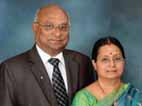
RID Basker Chockalingam
Ann Malathi
Dear Rotary Leaders,
Rotary Zone Institutes give opportunity to Rotary leaders, past, present and future, to meet and greet each other, exchange ideas and debate on how to take Rotary forward. Malathi & I deem it a privilege and pleasure, to invite you and your spouse, to Rotary Institute 2018, to be held during October 5–7, 2018, at Hotel Leela Palace, Chennai. With a set of wonderful speakers and world class entertainment, this will be truly an Institute with a difference. We will have the rare opportunity of having with us the Rotary senior leadership, who will make the event a memorable one for us. The dynamic Institute Chairman PDG I S A K Nazar and his wonderful team are making every effort, to ensure that, we all have a grand Rotary Institute 2018 — Passion To Serve — at Chennai.
With warm regards,
RID Basker Chockalingam, RI Director (2017–19)



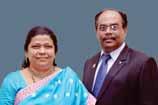
Ann Afzalunnisa
PDG I S A K Nazar

Dear Rotary Leaders,
Greetings from Team — Rotary Institute 2018. It’s a great opportunity given by Director / Convener Rtn C Basker to have our Rotary Institute 2018 at Chennai, at the grand venue — Hotel Leela Palace, Chennai — on 5th, 6th and 7th October 2018. Please be ready to witness one of the most memorable Rotary Institute at Chennai. We are all set to deliver an outstanding and memorable Institute. With a galaxy of eminent speakers, a new experience in entertainment and all that a successful Rotary Institute can be remembered for, awaits you. On behalf of Rotary Institute 2018 Team, I welcome you to Passion to Serve, Rotary Institute 2018. Please register immediately.
PDG I S A K Nazar
Chairman — Rotary Institute 2018
Name: Rtn. ............................................................ Call / Badge Name:.....................................
Classification: ...............................................................................................................
Address: ......................................................................................................................
City: .................................................. Pin ............................................ Country .............
Mobile: ................................................... e-Mail: ...........................................................
(Note: Include country and area code for Telephone / Fax Number)
PDG IPDG DG DGE DGN DRFC DMC DRC
Home Club: ................................................................. RI District: ....................................
Name of Spouse: ........................................................ Call Name: ..........................................




*Kindly tick whichever is applicable.
*Please note that the Accomodation is purely on first come first serve basis.
The cheque and draft shall be in favour of “Rotary Institute 2018” payable at Chennai.

Online payment details:
Account Name: Rotary Institute 2018 Bank: Karur Vysya Bank Branch: Saidapet, Chennai - 15 Account No.: 1651155000067299 IFSC Code: KVBL0001651
The Institute registration covers the following:
a) Inaugural plenary on Friday, Oct 5, 2018 followed by dinner.
b) Lunch and dinner on Saturday, Oct 6, 2018.
c) Lunch on Sunday, Oct 7, 2018.
The other events such as GETS (Couple), DG Seminar, Membership Seminar, DGN Seminar, COL, TRF Seminar, Foundation Dinner have additional registration as mentioned above.
Date: ............................................
Signature: ..................................

V Muthukumaran
Despite many appeals and written complaints to set right their pathetic conditions, the government primary and middle schools did not get any favourable response from the State Education authorities. Rotary Club of Gwalior Imperial, D 3053, has totally revamped two
government schools — a primary and a middle school — adjoining each other at Sirol in Gwalior. The dilapidated building has got a fresh coat of paint and a new boundary wall to give a new lease of life to the school.
The club carried out this project, armed with the experience of converting two similar schools at Naka Chandravadni, an area
nearby, into Happy Schools last year. “We finished the entire project in six months fulfilling all the basic needs of the faculty and the requirements of the students. They are very much happy now with a set of new furniture, blackboards and revamped classrooms,” says Amit Rathi, Club President.
Since the schools were on the main road,

the lack of a boundary wall was one of the main problems for the school authorities. “With a common wall for both the schools, we have ensured the safety of the students. Eight classrooms were given a makeover with tiled flooring and the walls getting a ‘theme paint’ to inspire the children. Pin boards, LED tube lights and dustbins were provided to create the right environment for learning,” he says.
One of the highlights of this project is the re- laying of underground sewer lines and renovating the four toilet blocks. “We have plugged the leakage which was not only an eyesore but totally unhygienic, and now sanitation prevails on the campus. Sanitary napkins are being distributed on a regular basis to ensure menstrual hygiene.”
The club has spent ` 6 lakh to completely revamp the twin schools in Sirol and the funds were mobilised through donations by members.
“We also used $1,000 from our DDF for donating furniture such as benches and desks,” says Rathi. The school renovation will benefit 250 students who now have a clean campus and neatly-furnished classrooms which will make learning an exciting experience, adds Rambabu Singh Rana, headmaster, Government Primary School, Sirol.
Recalling his frustration over his inability to get the school building renovated, he says, “All our efforts to seek government help to restructure the school fell on deaf ears. But this Rotary club intervened and in six months, brought a complete transformation.”
The club is now engaged in creating a play area and garden for the children.
The club has also donated a water tank and got power supply on a permanent basis for the schools at Naka Chandravadni this year to complete what they had taken up last year. “Two ceiling fans in each classroom and a well-stocked library were added to the list of facilities we had given to them,” says Rathi. A water pump with
a pipeline for round-the-clock supply of water in toilets has been installed. The club has spent about `6 lakh to create these Happy Schools at Naka Chandravadni for about 275 students.
Based on a survey conducted to understand the needs of the community, the club has donated two hematology analysers to
government hospitals — Civil Hospital, Morar; and a Blood Bank attached to the G R Medical College and J R Group of Hospitals — at a cost of `9 lakh, to serve underprivileged patients.
“The 5-part blood cell counter at the Civil Hospital will serve about 20,000 patients a month; while the 3-part blood cell counter at the blood bank will help 20,000 donors. These

facilities include separating and using blood components.”
All our efforts to seek government help to restructure the school fell on deaf ears. But this Rotary club intervened and in six months, brought a complete transformation.
Rathi adds that with the lab reports having the club’s name on the top, this will enhance Rotary’s public image in the community.
The club was recognised by DG Rajkumar Bhutoria for recording 24 per cent growth in membership which stood at 156, up from 126 last year and “the club prides itself in couples membership,” points out the club president.


The famous lac bangles of Jaipur in Lahariya style and colours have become a big craze among young women these days. The pink city’s colourful artefacts like lac ornaments, along with very recently initiated beautiful lac wall paintings, are adored and admired greatly by people throughout India. Multicoloured neck pieces, rings, earrings in different shapes, lac bangles studded with beads and colourful glass stones like octane, or stones imported from China or

Australia, enhance the beauty of these traditional ornaments.
In recent times, through innovative techniques such fine products are being crafted skilfully with bronze, steel and other alternate materials that most of the time it becomes very difficult to identify the original lac products.
In traditional Indian families, lac bangles are also symbolised as suhag, gulali or haraa choodha, usually worn by a new bride just after marriage and for a certain period. Pink coloured bangles are


worn exclusively during Holi. All in all, these bangles are considered very auspicious and specially purchased for festivities like Teej, Gangaur, Karva Chauth and other special ceremonies.
The art of making lac products is over 300 years old. To establish lac art industry in Rajasthan, the Jaipur Maharaja brought artists from Arabia and also from other States of India. During the formation of Jaipur, Maharaja Jai Singh II shifted the master craftsmen of lac work from Amer to Jaipur and today Jaipur has become a hub of lac industry.
In Rajasthan, the lac business is usually done by Lakhera and Manihar clans. Hindu families doing lac work are called

Lakhera and the Muslims engaged in lac business are called Manihar.
Maniharon Ka Raasta, the lane where these craftsmen were placed in the pink city, is today acclaimed nationally for lac work. Situated in old Jaipur at Tripoliya Bazar, Maniharon Ka Raasta is a narrow crowded lane where hundreds of lac work artisans give shape to such unique art pieces for local sale and bulk export. This street is extremely busy, being jammed with buyers, and a cacophony of sound — of the buyers, sellers, workers and the honking of horn from the vehicles crawling here greets passersby. Add to this the flames from the craftsmen’s furnaces or wooden stoves and the entire street

with so many lac shops gets a unique character. The process of making lac products involves heating, combining, kneading, hammering and shaping through moulds or by hands.

Basically the raw material or lac is the byproduct/waste from small insects and is acquired from trees such as Peepal, Bud and Plasa. Lac is usually imported from Bihar, Uttar Pradesh
and some other areas.
After cleaning this waste, it is heated in large vessels and is formed into a hard circular base.
Lac is first heated on furnace or bhatti with charcoal and is similar to glue or a semi-liquid sticky material. It is then mixed with different natural colours like red, green and yellow, and sometimes with Japanese golden or silver glitters. The products that can be

In traditional Indian families, lac bangles are also symbolised as suhag, gulali or haraa choodha, usually worn by a new bride just after marriage and for a certain period.




designed with pure lac are bangles, pens, brooches etc. Sometimes it is mixed with papermache to craft beautifully designed artefacts.

The entire process requires a lot of accuracy, skill and time, and the ratio of lac in the final product varies.
Later the ready products are decorated with beads or colourful glasses, and this work which requires finesse is predominantly done by women. The decoration process is called Chipai. It is nothing short of amazing that the size of the lac bangles can be easily adjusted or mild cracks in any product can be mended with mild heating, tender fabrication and gentle moulding. These craftsmen are so competent in their skill that by just seeing a woman’s hand, they can set the size of the bangle. However, lac products are heat prone and Rajasthan’s extreme hot weather is a major obstacle for this art.
“The younger artists are doing many variations in the lac products designed now. The cost range of these products is between `10 and `2 lakh,”says Shilp Guru and 2013 National Award winner Awaz Mohammad.




Awaz Mohammad, his wife Anwar Jahan and their entire family, including two sons and daughters, are engaged in lac work.
Conferred with many awards and one who has travelled globally 57-yearold Mohammad says, “I used to give training at IIJ, Mumbai, Amity and craftsmen of NGOs from


other States too.” But he regrets that “due to lack of encouragement from the government, and competition with other substitute articles, these days lac work doesn’t get good response as compared to earlier times. I fear that in the coming days original and genuine lac work will vanish.”



The younger artists are doing many variations in the lac products designed now. The cost range of these products is between `10 and `2 lakh.


Mohamed Shamsher, an expert craftsman whose forefathers started this work 200 years ago, and whose entire family is now involved in the lac business, says this is a seasonal work and sale for these items increases during festivals or the marriage season. “During the emperor’s time, we used to make a unique lac piece called Gulal Gota, especially for the Holi festival. Gulal Gota is a small ball or potli made from a fine lac sheet filled with herbal colours. To make the Holi festival more enjoyable, these colourful, but harmless, potlis were thrown around.”
Forecasting a bleak future for the lac craft, he says this is exactly why “my entire family is educated. We have made sure that both our children and grand children get a proper education. Seeing the unsatisfactory conditions that are affecting this craft, and the extreme hard work required to do the work which fetches not much income, we feel that our younger generation will not pursue this profession in the coming years,” he sighs.
Pictures by Rtn Anubha Agarwal, RC Jaipur, D 3054. Designed by Krishnapratheesh

PRID Shekhar Mehta Chairman, Rotary India Literacy Mission


RILM Chair Shekhar Mehta (centre) with HRD Minister Prakash Javadekar (right) and Jhilam Roy Chowdhury, RILM’s Deputy Director-Programmes.
RILM Chair
Shekhar Mehta, Dr Aapga Singh, COO, RILM and Jhilam Roy Chowdhury, Deputy Director - Programmes, met HRD Minister Prakash Javadekar to take the T-E-A-C-H programme forward. The minister was impressed with RILM’s E-Shiksha programme and he invited Mehta to the Operation Digital Board meeting being held at the Shastri Bhawan, Kolkata. A similar discussion was held with
the Special SecretarySchool Education Reena
Ray who, convinced with the methodology of using primers for teaching adult non-literates, requested RILM to send her the tutorial video. She said that the government has encouraged District Collectors to allocate money for adult literacy programme.
E-learning facility in Punjab schools
RILM is partnering with the Punjab government to install
E-learning facilities in 19,272 government and government-aided schools in the State. Initially, this MOU will be implemented for a period of three years.
Schools will be given audio-visual hardware and relevant software. The State government will provide hardware comprising a projector or a TV with Android compatibility and establish labs in the schools. RILM will provide the software compatible to the
hardware; develop e- content as per the State board curricula; train teachers to use the facility and evaluate the implementation of the digital education and learning outcome of students. As of now, the programme has been extended in 13,322 government and government-aided schools.
SBI Foundation supports E-learning Under the Digital Classroom project funded

by SBI Foundation for 310 schools, RILM, in partnership with the TRIUMPH Foundation — a trust of Rotary Club of Thane Hills — has installed E-learning facilities in 171 schools in Maharashtra, Uttar Pradesh and Karnataka, and progress is being done in the rest of the schools.
E-learning has been facilitated in 50 schools in Karnataka, 118 schools in Maharashtra and in Uttar Pradesh, 89 of the 142 schools identified have been provided digital learning facility. Multimedia content in local language, mapped with State Board curriculum, have been installed in the projectors. An online portal has been designed
and linked to RILM website for procuring all information related to the implementation of the project. The portal is open only for the host Rotary/Inner Wheel clubs and concerned vendors.
Post installation report and monitoring report will be captured through this portal.
Rotarians Kishore
Lulla, PDG R S
Nagarjuna, DLCC
Prashantha Ramachandra, PDG D S Ravi, DLCC
Swati Gupta, Vijay Namdev, I S Tomar, D N Raizaday, PDG Ranjeet Singh, DLCC Anand Mukherjee, Suneel Agarwal and Lalit Mohan Gupta are few star sponsors from Districts 3170, 3181, 3182, 3012, 3110, 3120 and 3100.
T-E-A-C-H at Toronto
Showcasing T-E-A-C-H projects at the RI Convention’s House of Friendship was a significant milestone for RILM this year. The stall was buzzing with senior Rotary leadership and convention attendees. With visitors from America, Italy, Mexico, Nigeria, Uganda, Ghana, Nepal, Bangladesh and Pakistan etc. the TEACH programme reached out to those who want to take up and implement it in areas where literacy is a big challenge. The Happy School vertical had the maximum takers, along with Adult Literacy and E-learning programmes. TEACH is all set to lay the foundation for
a revolution in global education and literacy.
Padho Bharat - Library Project
Rotary Club of Mansa, D 3090, created 200 libraries in government in Punjab.
D 3120 received 13,500 English storybooks and reference books from RILM to create libraries in government and government-aided schools.
RILM provided 3,000 books to Inner Wheel District 314; 16 clubs have distributed 1,700 books and created libraries in 17 schools.
IW District 329 was allotted 5,000 books. 13 clubs have distributed 1,400 books to create libraries in 14 schools.
are pretty hard to kick out, aren’t they? Or so it seems. Portia Nelson has expressed it with beautiful eloquence in An autobiography in five short chapters:
Chapter one: I walk down the street. There is a hole in the sidewalk. It is a very deep hole. I fall in. I am helpless. It isn’t my fault. It takes forever to find a way out.
Chapter two: I walk down the same street. There is a deep hole in the sidewalk. I pretend I don’t see it. I fall in… again. I can’t believe I am in the same place, but it isn’t my fault. It still takes a long time to get out.
Chapter three: I walk down the same street. There is a deep hole in the sidewalk. I see it is there. I still fall in… it is a habit, but my eyes are open. I know where I am. It is my fault. I get out immediately.

Chapter four: I walk down the same street. There is a deep hole in the sidewalk. I walk around it.
Chapter five: I walk down another street.
“I understand.” You draw a deep breath when you read Portia’s parable. When we are into a habit that’s harmful for our wellbeing, we often don’t even know we are in a hole! And, with repetition, that hole becomes a comfort zone. I’m so comfortable in my self-pity, for example, that when a well-wisher tries to help me climb out, I bark: “You don’t understand what I’m going through! You are so insensitive!” What I’m really saying through my agitation is: “Be gentle and empathise with me. For your judgement — that I need to be pulled out — treads on my pain.” What all of us need to hear is a sincere “I understand.” It may not take away our physical pain, but it does reduce our

mental suffering. The words “I understand” from another person sets off a self-healing mechanism in our mind and body. When we feel supported and nurtured, we heal ourselves. We need a healer — doctor, friend, teacher, spouse, sibling — full of this generous elixir called ‘understanding’ to be with us because it is tough going it alone.
The power of conviction. This understanding brings us to a point where we can make that leap to a better, healthier life using our own mental muscle of conviction. If I am convinced that smoking de-stresses me despite knowing it’s a health hazard, I am practically powerless to quit smoking. So I need to change the conviction. How? The brain needs daily reminders. The brain communicates with the entire body through hormones and neurotransmitters. So when the brain receives instances

daily through Youtube, for example, of people who have quit and their lungs are thanking them, a part of you begins to live through their healing experiences… . Your conviction to quit grows subtly, silently, surely, until one day you quit! Will bows gracefully to Conviction.
Strengthening the will. Yet, we may say, “My willpower is weak.”
We joke, “I can give up sweets any time. I’ve done it several times!” The fact is: willpower is a mental muscle. The less we exercise it, the more we weaken it. And when we look at the other areas in our life, we see how we pushed ourselves to finish a project despite being exhausted, how we drag ourselves out of bed in the wee hours to get things done before rushing off to work. Each time we’ve done this, we’ve strengthened our willpower. Similarly, take this decision to quit sweets as seriously, sincerely, with
the same determination. “To plant a garden is to believe in tomorrow,” said actress Audrey Hepburn. Plant a garden patch filled with “No” on one side, and an entire field of “Yes” on the other; to exercise regularly, eat healthy food, nourish the mind with healing thoughts, nurture good relationships, and so on. As you grow confident, so will your health.
The fact is that everyone wants to take on new habits. They even know the purpose: I don’t want to be a burden on my children. I want to lose weight. I want to be healthier. Yet, however well-intentioned, however wise the purpose, it still doesn’t seem to stick. Remember that every purpose needs a process and an outcome. For example, if you run a marathon and are the sole runner to come in last to touch the finish line, you are still cheered as a winner. You still feel like a winner. You appreciate the process you have gone through. You have, in some subtle way, discovered a new, more determined, better version of yourself in the process.
So is it with adopting a new, healthy habit. On a diet-plan you may not have lost as many kilos as you wanted but it’s important to recognise your efforts, to cheer your progress and be inspired by other people’s compliments. Never demean your efforts. Rather, exalt them. Continually celebrate your efforts, your inner strengthening and progress. If despite all your efforts, you fail to achieve the result, be highly aware that you have transformed, grown and achieved inner triumphs. Suppose you decide to conduct your own workshop; you will learn everything possible about your subject, financing, marketing, etc. But then, even if your workshop never takes off, you have still acquired and absorbed new knowledge and useful skills. You may not be the sun that blazes into fame and fortune,
We can make that leap to a better, healthier life using our own mental muscle of conviction and giving the brain daily reminders.

but you can be the star that shines consistently in all that you do. Remember, effort is never wasted.
Find friends-in-fitness. This is very important. If you have a group that has exercised together, dieted together and become friends, stay with it. The shared common goals of losing weight, of eating low-fat foods, of thinking positively, of leaving old paths and treading new healing ones, all of this together, is priceless. There’s something powerful about belonging, familiarity, supporting one another by sharing health tips and laughter and empathy, there’s beauty and strength and dignity in inclusion. As Anne Frank put it with such poignant simplicity: “We all live with the objective of being happy; our lives are all different and yet the same.”
Ultimately, this is what I’ve learnt in my life dedicated to fitness and writing: Gratitude keeps you glowing. Exercise keeps you strong. Your imperfections keep you human. Failures help keep your sense of proportion. Success keeps you motivated. And good habits? They keep you going!
The writers are authors of Fitness for Life and Simply Spiritual - You Are Naturally Divine and teachers of the Fitness for Life programme.


Sandhya Rao
That’s what the best books always are.
When you read, you get a peep into a world of ideas and insights divergent from your own.
If you are a reader, you know that books can be your best friends. If you are not, know that books can be your best friends. Reading is a conversation conducted silently most of the time, but if you are in the habit of reading aloud it can be auditory too. The thing about best friends is, you can discuss anything under the sun. They listen when you sound off something, and you listen in turn.
Recently I read Elif Shafak’s Three Daughters of Eve (2016). Shafak (the word means ‘dawn’) is a Turkish writer

based in London and has many fiction and nonfiction works to her credit. She is one of very few to highlight the massacre of Armenians by Turkish authorities under the Ottoman Empire during the First World War in her book, The Bastard of Istanbul. The response to a book, as to a film or a painting or even a piece of music, is subjective. So, even if there are conflicting opinions as to the merits of Three Daughters of Eve, there can be no argument about the fact that it throws up political, religious and philosophical concerns, and what most
engages each reader depends upon each reader’s disposition.
The central character of this novel is a woman called Nazperi who’s grown up with a progressive-minded if dissolute father and a disciplined if excessively orthodox mother. Although they love their daughter, each in their own way, the atmosphere at home is not congenial. Peri escapes by going off to study in Oxford. There she befriends two women as alike as sugar and jaggery, and she takes a course called ‘God’ run by a charismatic professor.

It’s ‘God’ not ‘Religion’ as the professor himself reminds his students and as Elif writes: “Whereas in former times, philosophers grappled more with the idea of God than with religion, now it was the other way round.” It is in this context that the professor cautions them against the ‘malady of certitude’.
“Certitude,” writes Elif, “was to curiosity what the sun was to the wings of Icarus. Where one shone forcefully, the other couldn’t survive. With certainty came arrogance; with arrogance, blindness; with blindness, darkness; and with darkness, more certainty. This he called, the converse nature of convictions. During these lectures they were not going to be sure of anything, not even the seminar syllabus, which was, like everything else, subject to change…”
“They were travellers too, companions of the road, having yet to arrive at any particular destination and perhaps never to do so. They were only striving, searching. For in a world of elusive complexity, only this was clear: diligence was better than idleness, spiritedness preferable to apathy. Questions mattered more than answers; curiosity was superior to certitude.”
Reading these two paragraphs I began to realise the ramifications of a comment once made to me by a nineyear-old. In the course of a classroom interaction he had said, “We know how to give answers, not to ask questions.”
Reading Elif threw light on the idea that maybe the more we think we know the less we really do and it could take a lifetime to even begin to grasp this fundamental truth, if ever. This shaft of self-awareness came from a passage in a work of fiction. Philosophers may have been screaming it from rooftops but their words had not pierced my faculties. It took a book.
In The Book Thief by Markus Zusak, a character called Max has to stay hidden away in the depths of a
house for fear of being discovered by the Nazis. Liesel, the daughter of the house, brings him things from the outside world to make him feel better:
“How do you give someone a piece of the sky?
“Late in February, she stood on Munich Street and watched a single giant cloud come over the hills like a white monster. It climbed the mountains. The sun was eclipsed, and in its place, a white beast with a grey heart watched the town.
“ ‘Would you look at that?’ she said to Papa.
“Hans cocked his head and stated what he felt was the obvious. ‘You should give it to Max, Liesel. See if you can leave it on the bedside table, like all the other things.’
Liesel watched him as if he’d gone insane. ‘How, though?’
“Lightly, he tapped her skull with his knuckles. ‘Memorise it. Then write it down for him.’ ”
When I picked up The Book Thief to look for a suitable example to illustrate the possibility of a meeting of minds, the book automatically fell open to the page that contained this passage. Was it a coincidence that it talks exactly about words and painting pictures with them? Reminding us of the power of word pictures and what the world’s greatest writers do for us?
Another book I read recently was a nonfiction work called Walking the Himalayas (2016) by Levison Wood. In it the author recounts his experience of walking along the Silk Road, starting in Afghanistan and going all the up to Bhutan on roads and paths actually used by people, traversing five countries in the process, the other three being Pakistan, India and Nepal. This is a region that’s been in the news for many years now. We are aware of the starkness of the landscape, the constant threat of terrorist attacks, the low literacy levels, the oppression of women.
With all these notions in my head, I read what Wood had to say about the Hunza Valley in the Gilgit-Baltistan region of northern Pakistan bordering the Wakhan Corridor of Afghanistan and the Xinjiang region of China. Not a particularly great address no matter how beautiful the region.
Wood writes: “The Hunza valley was the basis for James Hilton’s 1933 novel Lost Horizon, the inspiration for Shangri-La — paradise on earth… Here the people were from the Burusho tribe among whom, like in Afghanistan, they liked to claim descent from the soldiers of Alexander the Great. Their dialect is unlike any other in the world, bearing no relation to the neighbouring Pashtun, Urdu and Persian languages and has left anthropologists bewildered for centuries.”
Sher Ali, a university professor from Hunza, tells Wood: “We’re different here. We are the Hunzakut — the people of Hunza. For centuries we have defended this valley against invaders — even the Muslims didn’t reach us until a hundred years ago.” Sher Ali makes it abundantly clear why the Hunzakut are different, despite the remoteness of their location and the widely held notion that education is anathema in that region: “ ‘It’s only because we’re so liberal here that we’ve managed to thrive. Do you know what the literacy rate is for Pakistan?’ ” And then Wood goes on to quote him as saying: “ ‘It’s a stain on the nation. How will we ever become first world if we don’t let our women read? … We have ninety-five per cent. All the kids go to school and we send hundreds to university. All the best surgeons and pilots come from Hunza.”
I had not known this and I thank the author for drawing this particular picture. It gives me hope because it upends a misconception and opens a window to possibility.
The columnist is a children’s writer and senior journalist.

After bagging 11 District awards last year, RC Thiruvannamalai Pearls, D 3231, kictstarted the new Rotary year with the installation of 12 new female members. The all-women’s club, instead of hosting a grand gala, set out the same day to distribute stationery kits to an orphanage — Epahtem —and donated utensils to the Aswanagasuranai Little Heart Home, another orphanage in Chennai.
In order to repair the pipelines and construct a compound wall at two panchayat schools in Chennai, the club members donated `50,000 to them.
With the help of PDG Sampath Kumar the club donated tricycles to a few physically-challenged people and planted 100 saplings in Ilandhalir, near Thiruvannamalai.

A tricyle being given to a beneficiary.

Adilapidated building, leaking toilets with unhygienic conditions, and classrooms that are woefully inadequate to impart education — that was how a survey team from RC Calcutta Yuvis, D 3291, found the Gayatri Hindi Vidyalaya when they visited it in the Serampore village in Hoogly district, Kolkata, in January 2017, during a field work to identify schools for their WinS project.
Soon the club under the leadership of its president Virendra Choudhury swung into action to renovate the school. With a budget working to ` 20 lakh, the club
roped in the Aditya Birla Jan Seva which is the CSR wing of Jayashree Textiles and together they transformed the school with new paint, toilets, wash facilities, water purifiers, benches and desks and blackboards for classrooms and addition of more teachers and classrooms. DG Brojo Gopal Kundu who inaugurated the school was happy that “the Rotary-CSR tie-up has helped more children to get quality education in a favourable ambience. I hope this transformed facility will attract more children to attend school and enjoy a better future.”

Amega veterinary camp was held at the government dispensary in Alanganatham village near Namakkal. Over 70 bovines were screened for various ailments.

The club distributed LPG stoves to needy women, and a water filter system and sanitary napkin incinerator to a government school in a village near Pudukkottai. Total project cost `75,000.
Buttermilk and juice were offered to the public to help them beat the scorching summer heat. The club also promoted Rotary’s public image by placing a banner featuring the End Polio theme in a market area in the heart of the town.

A5kWp solar plant was installed at the Rotary Community Centre at a cost of ` 5 lakh. The facility was funded by Allen Diesels India under its CSR initiatives. The plant was inaugurated by DG Subhash Jain in the presence of club members.

Ablood donation camp titled Mahadaan was held, along with the Indian Medical Association, the Round Table Bikaner and 18 other service organisations. Over 95 units of blood were collected at the camp which was inaugurated by Union Minister Arjun Ram Meghwal.
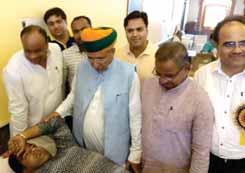
Four
Rotary Reading Rooms were set up in the city and a nearby village so as to encourage reading habit in children residing in the region. The club plans to set up more such reading rooms; it has tied up with few other NGOs to provide tuition and mentoring facilities for the needy children.

Under the club’s School Chalen Hum project, the Rotarians visit the underprivileged colonies in the town and encourage girls employed as maids to rejoin school and also makes efforts to get admission for them in nearby schools. Children are taught basic literacy and trained to maintain cleanliness and hygiene in their localities.
Ascreening camp for cancer and eye disorders was organised at the Civil Dispensary. Doctors from YouWeCan Foundation of cricketer Yuvraj Singh did the cancer screening while ophthalmologists from the J P Eye Hospital, Mohali, took care of the eye camp.


Soaps were distributed to village women and children at a WinS camp in which an awareness was created on the need for handwashing and adopting sanitation practices.

Afreezer box was donated to Gurudwara Guru Singh Sabha at Guru Nanak Pura. It was sponsored by Dr Indranil Banerjee in memory of his father Dr P Banerjee. The district has a target of donating100 such mortuary freezers through the clubs.
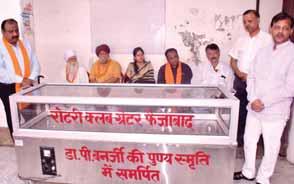
An interactive Science Centre with a capacity to seat 80–100 students was built at Hire High School in Pune at a cost of `18 lakh. The facility was conceived by Rtn Aditya Devadhar and displays over 60 projects made from sustainable material.

Aone-day picnic to Funland Paradise Waterpark was organised, along with the Rotaractors, for 150 children of Manav Seva Orphanage. They were given a hygiene kit and were entertained with a magic show and games.

Over
300 raincoats were distributed to Thane traffic police in the presence of JCP Madhukar Pandey and Club President Baljinder Singh Kumar. Pandey appreciated Rotary’s effrot to usher in a better world.

Noted
Tulu actors Devadas Kapikad and Naveen D Padil were presented with Vandana Awards at a grand ceremony held in association with the Rotaract Club of Mangalore City. Mayor Bhaskar Molly was the chief guest.


In partnership with the police department, the club arranged a blood and eye check-up camp for vehicle drivers on the occasion of Road Safety Week. Over 200 drivers benefitted from this project.

Rotary Initiative for Sporting Excellence (RISE), an annual event, was inaugurated by Kerala Minister Kadakampally Surendra. It had a participation of 134 clubs and the total cost was `10 lakh. Various games were conducted to promote friendship and goodwill.

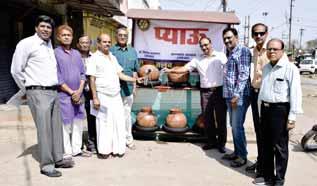
Dental and physiotherapy equipment worth $33,000 were donated to Sri Ramakrishna Math Charitable Dispensary and Diagnostic Centre under a global grant scheme. The international partner was RC Melawati, D 3300, Malaysia. A new block was inaugurated in the presence of IPDG R Srinivasan, Mutt President Gautamananda and Principal Secretary Dr J Radhakrishnan.

Atreeplantation drive was organised, in association with Shemford Futuristic School, in which 60 saplings were planted by students, teachers and Rotarians. A drawing competition was held for children on the theme “My green world”.

Several drinking water booths were set up by the club to provide the citizens respite from the summer heat. These very visible water booths have further enhanced the public image of Rotary.
Afew days ago, a friend who is otherwise quite a decent fellow, announced that he doesn’t read fiction. His remark reminded me of an incident 40 years ago. A girl friend who thought I was frittering away my life tried to force heavyweights like Prem Chand, Tagore, Bankimchand Chattopadhyay, Sartre, Simone de Beauvoir, Virginia Woolf, etc on me. I fled telling her that I hated all novels and that when I was forced to read one, as on a tedious train journey, it was to James Hadley Chase, Sidney Sheldon and Gulshan Nanda that I turned. Disgusted, she turned her attention to someone else. I was quietly able to return to the only form of private entertainment that was available then — reading.
That may sound simple now but it wasn’t in those days. Books were not always easily available everywhere and you had to nurse good books in the same way as you nursed Scotch. But those days of deprivation have given way now to plentiful supplies. Not only that: along with the scotch bottles which have become larger, story books have also become bigger. The 250-page book which you could read in three days has been replaced now by 800 page tomes that are difficult to hold. After much cogitation, I have concluded that this must be because of the bigger advances made now. The higher the advance, the more voluminous the book!
It’s the American way: jumbo size is what counts as value for money.
Books were not always easily available everywhere and you had to nurse good books as you nursed Scotch. But those days of deprivation have given way to plentiful supplies.
Just look at the evidence. Children’s books were hardly ever more than 200 pages. Most were even less. In contrast, the great super-hit author, J K Rowling, wrote 350 pages for the first Harry Potter book published in 1997. The subsequent books have been even fatter. This has made me wonder: has the attention span of kids increased in the age of Twitter, Facebook etc or do they merely skim the books for the story rather than the reading pleasure?
As for fiction for older people, Rowling has also started writing crime fiction under the pseudonym Robert

Galbraith and her first book was almost 450 pages long. The same thing is true of Jeffery Archer also. Earlier, his books would be around 300 pages long. But now he writes 6-part series, in which each volume is more than 400 pages. And if you look around you will find that the same thing has happened with many other highly successful writers. You can’t carry these heavies around comfortably while travelling or read them in bed or, for that matter, finish them over a weekend. As entertainment, they get zero marks.
In contrast, most Indian writers who publish in India for little or no advance write far less, perhaps because of that reason. That not only makes it easier to read them and carry them around, if they are awful, they also fit more easily into normal dustbins which can’t accommodate their fat English counterparts. But the best part of Indian books is the translations, of which several hundreds are available now from all Indian languages. And such wonderful stories too. Even if some of them are boring, collectively they show why English is a must for cultural integration.
But, alas, it is not easy to find these books. The bookshops don’t put them on display and often don’t even stock them because the commission they get on them is not worth the cost of the shelf space. The good news, however, is that you can get all of them online, for a pittance that too.
In a thoughtful gesture, RC Belgaum Midtown, D 3170, held a lung check-up camp for traffic policemen in the city. The camp was organised to “make them healthy and happy, help them to serve better and to bring smiles on the faces of their family members,” said S M Naik, Club Secretary.
Over 150 traffic police personnel, both men and women, were benefitted by the camp and some of them told the club members that this was the “first time that somebody had taken steps to care for our health as so far the government has not done anything in this regard.”

City Police Commissioner D C Rajappa and ACP Lakshminarayan coordinated the event while the Club President Vilas Badami and Project
Chairman Dr Vijay Pujar made necessary arrangements for successful conduct of the camp. It was Prof Udaysingh Rajput who mooted the idea of
holding such a medical camp for traffic policemen who spend more than eight hours a day to regulate traffic on the polluted streets of Belagavi.
The Hamburg convention will draw attendees from around the world. Do you have an idea or project that you want to share with your Rotary family? Breakout sessions can inspire attendees, help them polish their leadership skills and give them new ideas for projects, fundraising, strengthening membership, and more!
Help the Convention team build a breakout programme that celebrates Rotary’s diversity! They are seeking sessions in English, French, German, Italian, Portuguese or Spanish. Visit https://on.rotary.org/ IC19sessions to learn more and submit your proposal. All proposals must be submitted online by Sunday, September 30, 2018.




Rtn Ralph Zuke, President of RC Fairview Heights, Illinois, rode a rickshaw 800 miles (about 1,285 km) from St Louis, Missouri, to the Rotary International Convention in Toronto. The 22-day ride raised $22,000 for TRF’s Polio Fund. He was received by RI President Ian Riseley at the Simcoe Park opposite the Convention venue on June 22.
Picture: Rotary International



Regn. No. TN/CCN/360/2018-2020 Licensed to post without prepayment No.TN/PMG(CCR)/WPP-431/2018-2020
Registered with Registrar of News Papers for India 3880/57 Rotary News Published on 1st of every month
Total number of pages in this monthly issue, including cover, 84. Price: `35





